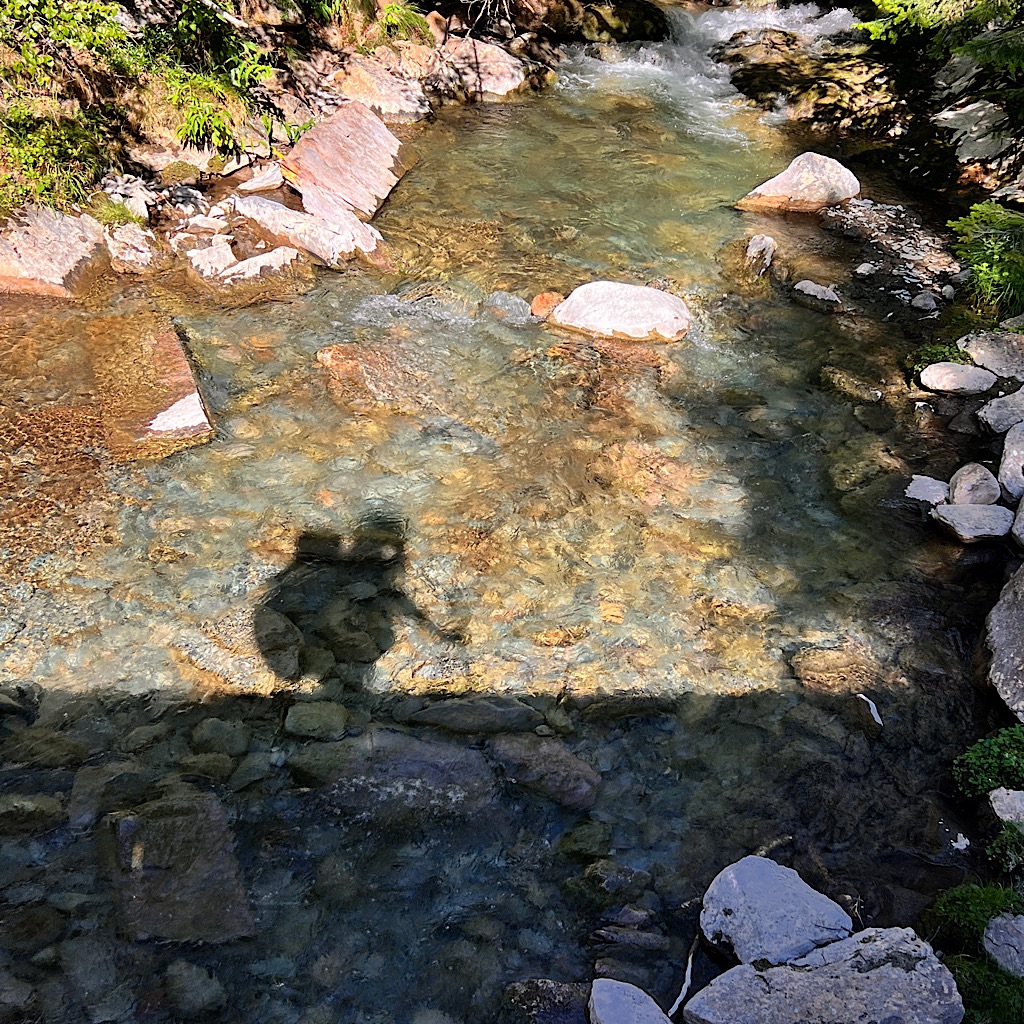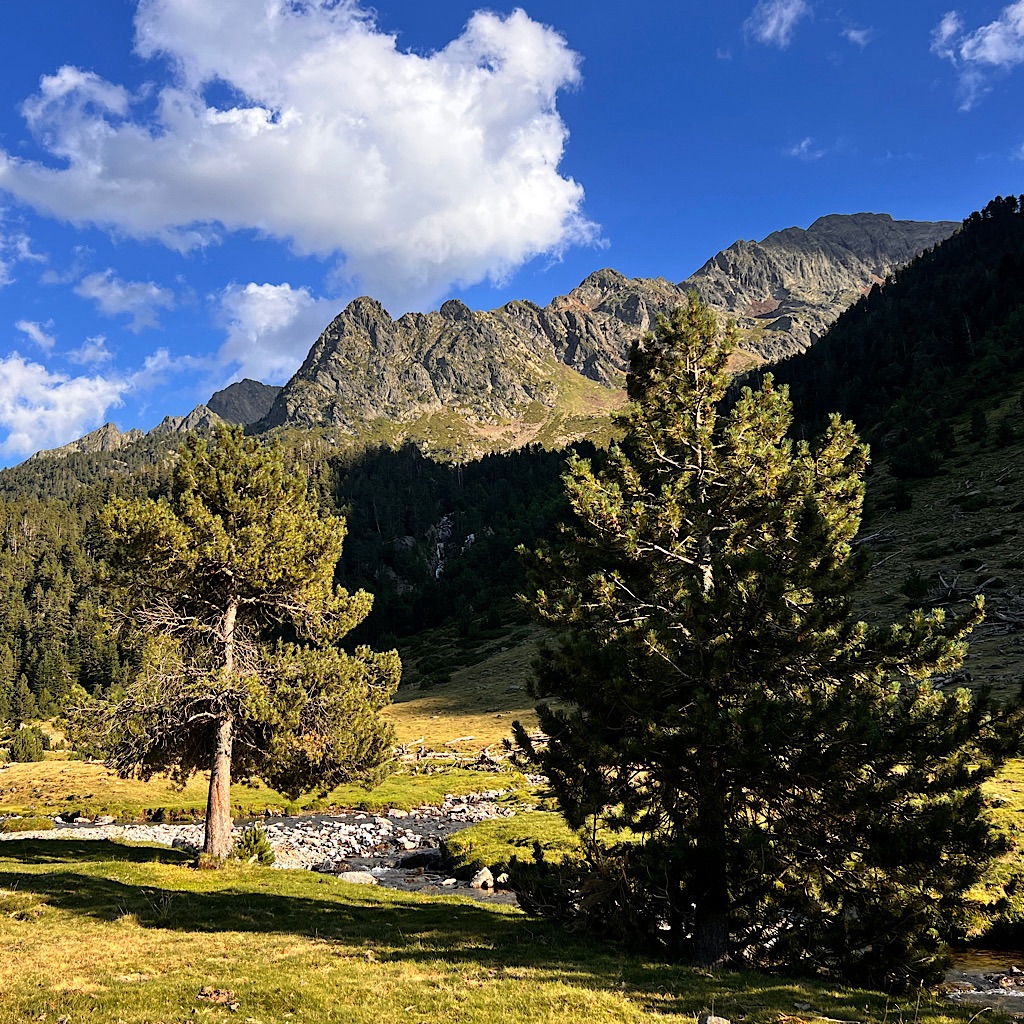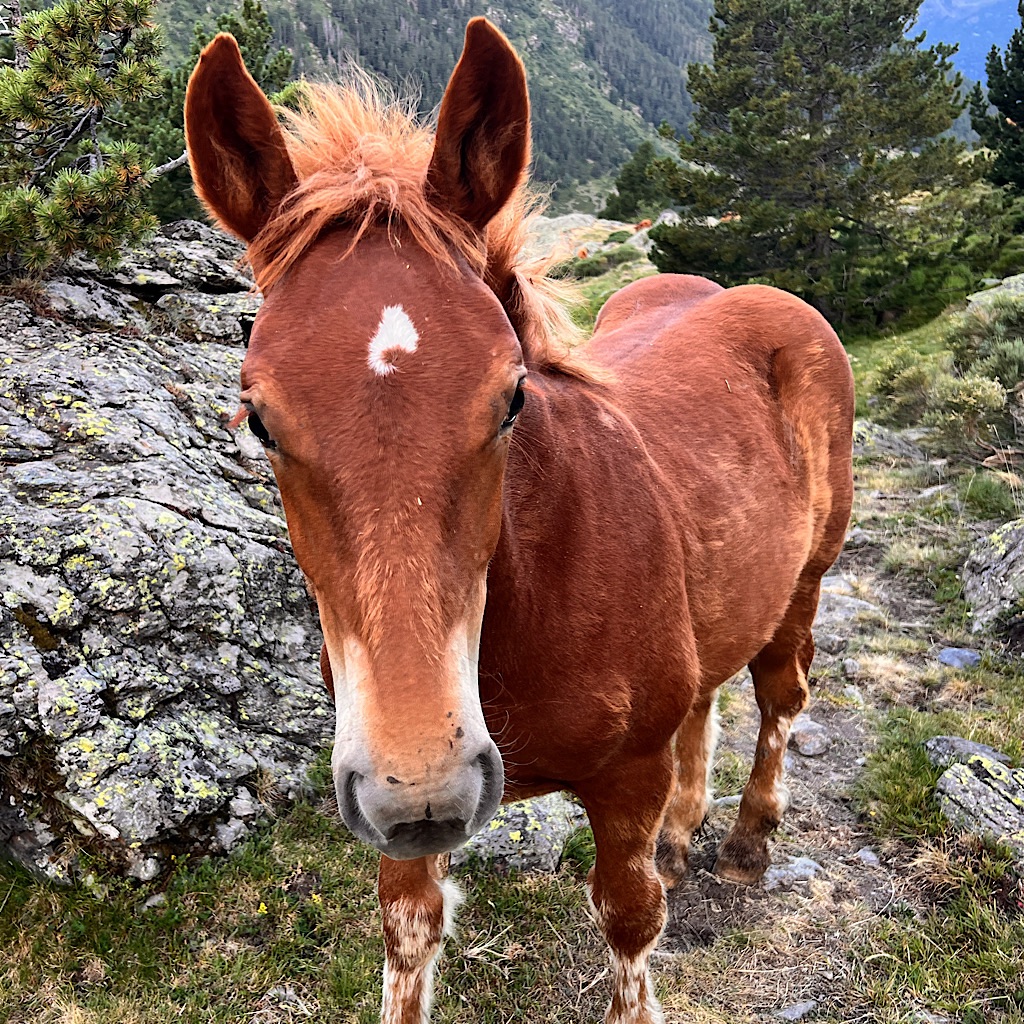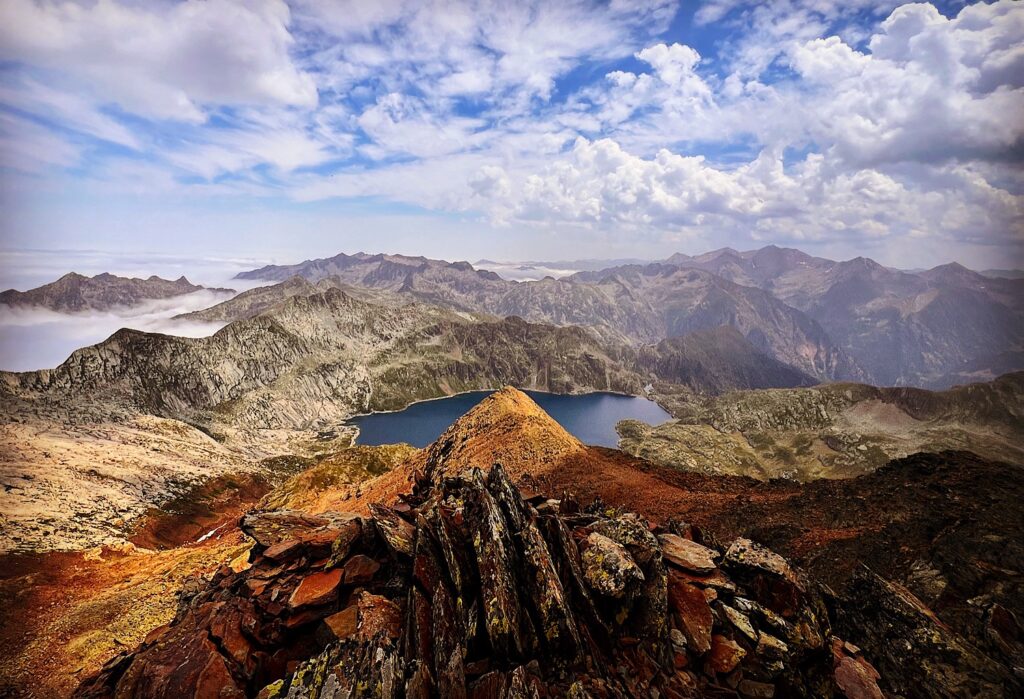
To Andorra
Day Twenty-three, Salardú to Estanyola del Clot de Moredo
Today was brutal.
It didn’t help that I got off piste and landed at a col on the other side of a nasty, steep and narrow ridge from the correct col.
Rather than correct my error by climbing back down and around, I took what looked to be a trail on my map over the ridge.
Let’s just say I made it with grit and determination, never dropping my poles – or me.
The guide describes today as “a very demanding route, including some stretches without paths or waymarks, as well as rough terrain, a steep climb and a large section of boulders.”
Forgot to mention I also went too low on those boulders and almost got trapped as they got bigger with more deep holes in between.
Needless-to-say, I’m happy to be tucked into the alicoop with a babbling brook feeding this tiny tarn.
The air is still and warm, the sky without a single cloud. Two Frenchman join me walking the HRP the opposite direction.
Also a German couple who skipped the hard bits and took the GR11, only to find this day an absolute shock totally without a clue as to which way to go – or in my case, the rare cairn seemed to send me completely the wrong way.
“Andrea!” the husband who is nipping at my heels yells over his shoulder at his wife already way behind and grabbing the ground for dear life on a path barely wide enough for a foot. “This rock is moving here!”
Like that’ll help things.
I’m not sure if things would have improved had I left earlier. Breakfast was so good at Hotel deth Pais, but didn’t begin until 8, so my day started late.
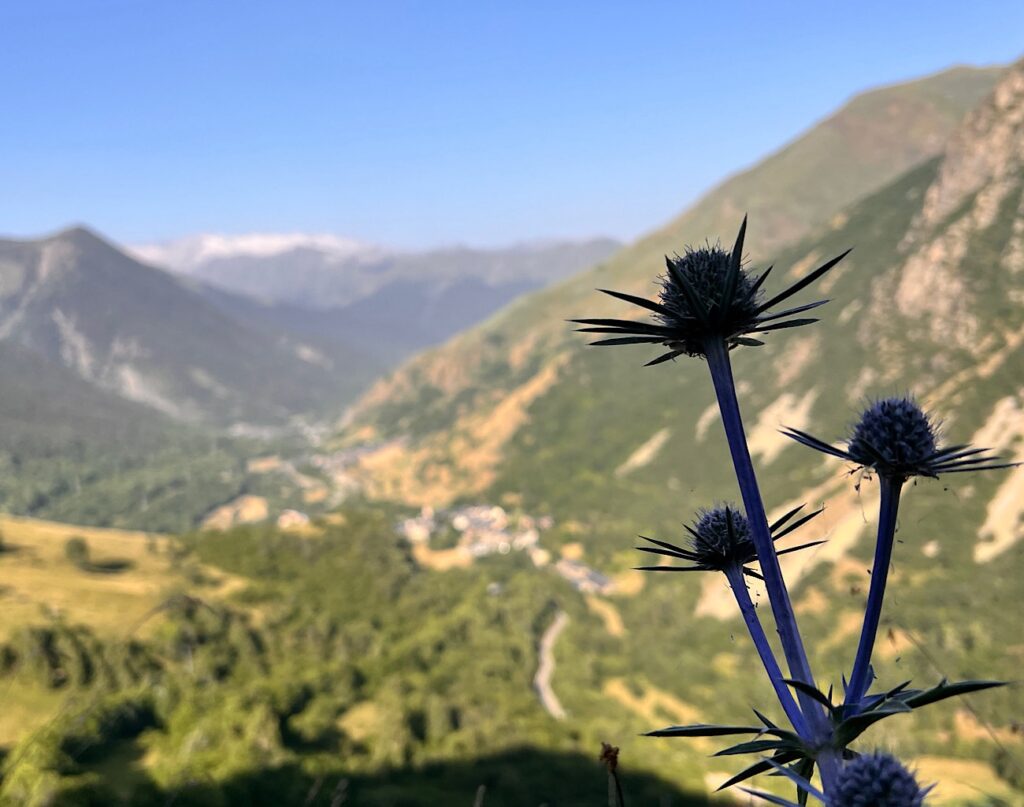
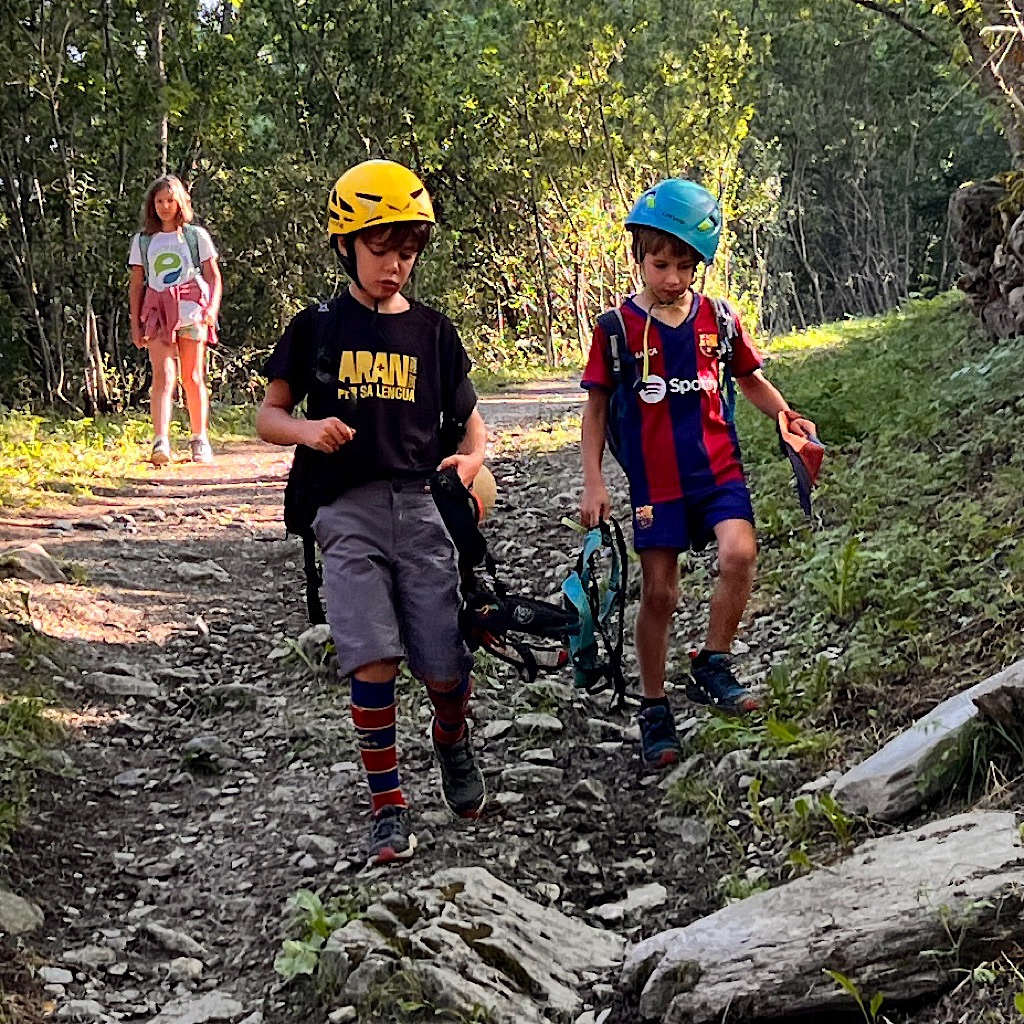
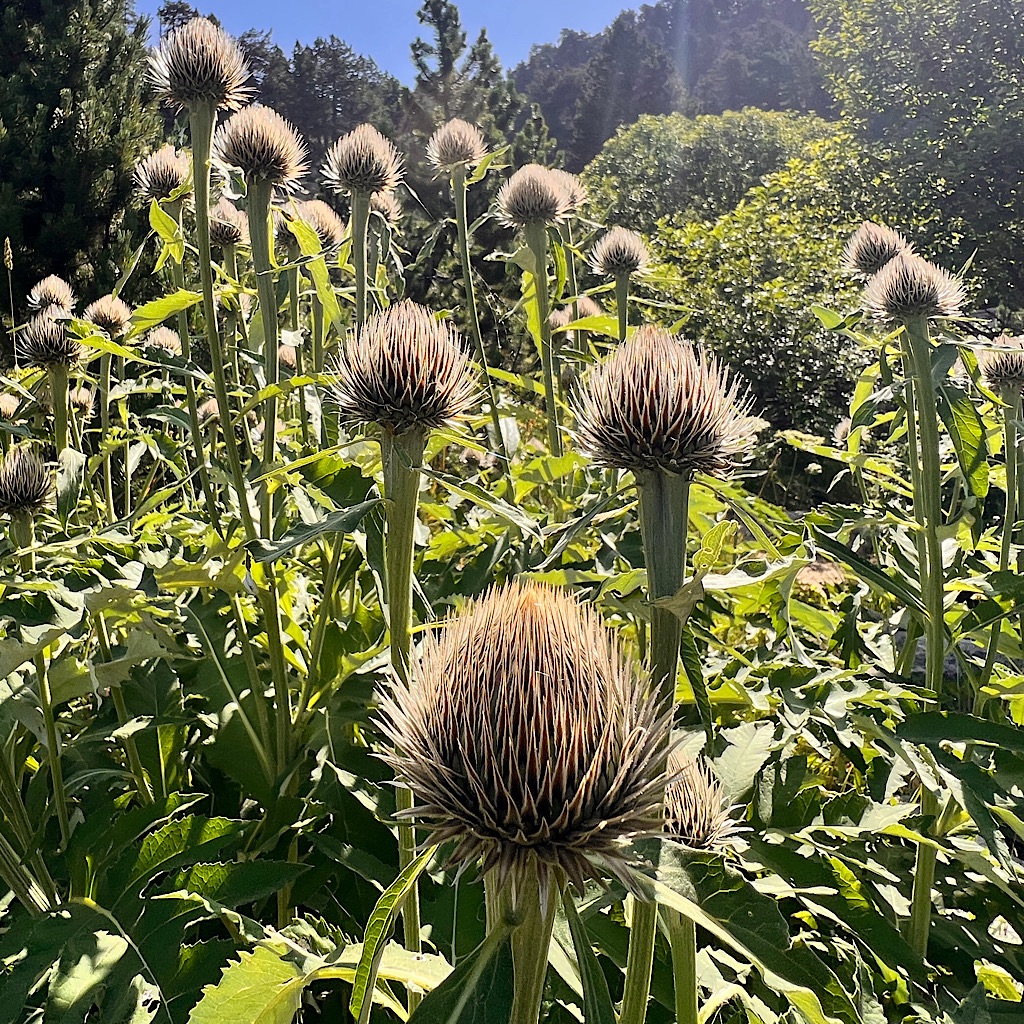
It’s hot walking up the roads and paths to the ski mountain and then to a set of lakes – Estani de Bacover – the first the most lovely with shade under pine trees, and wildflowers covered in bumblebees.
It’s all steep but on trails where you can get lost in the beauty surrounding you like the ever-changing views into the valley, Salardú a sweet memory now, and all the wildflowers plus crickets, frogs, birds.
The guide warns me to get water at the final lake, and I drink up and eat among horses and cows, bells dinging.
But then it’s the steep climb without trail. Perhaps the exertion distracted me, or trying to find good placement for my feet. I notice I’m slightly off of the GPS track, but figure it all works out in the end.
In a sense it did in that I met the ridge without tumbling backwards, but as I mentioned, I had a major set of rocks in between me and the Tuc de Marimanha.
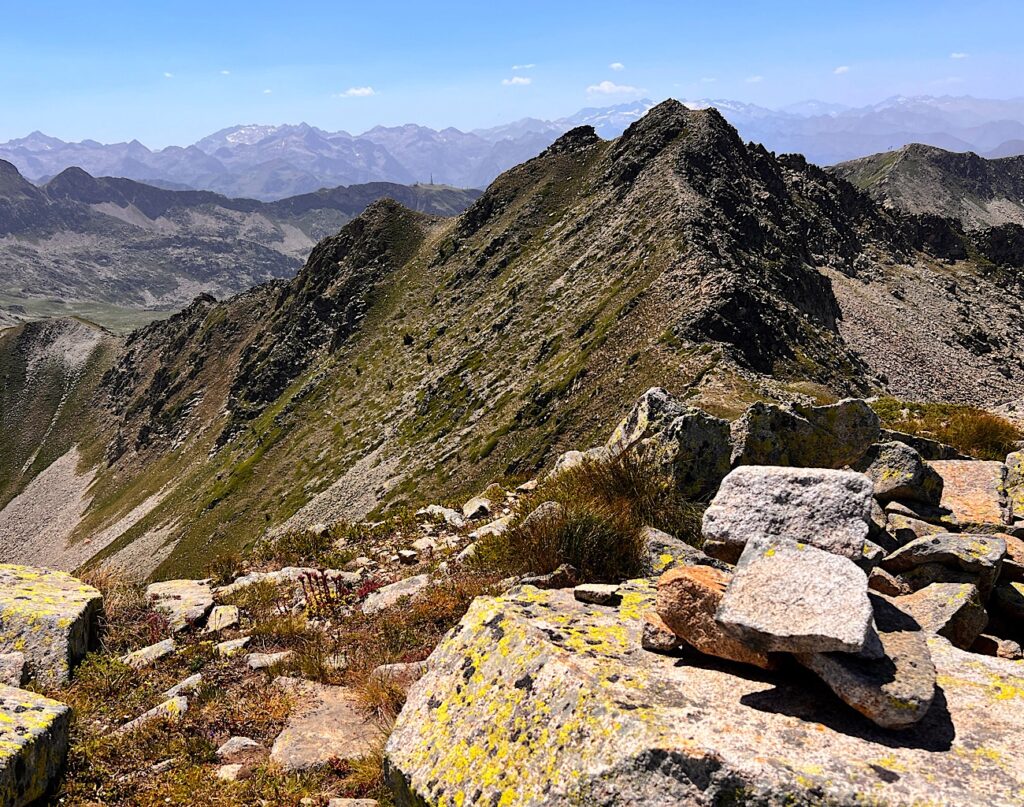
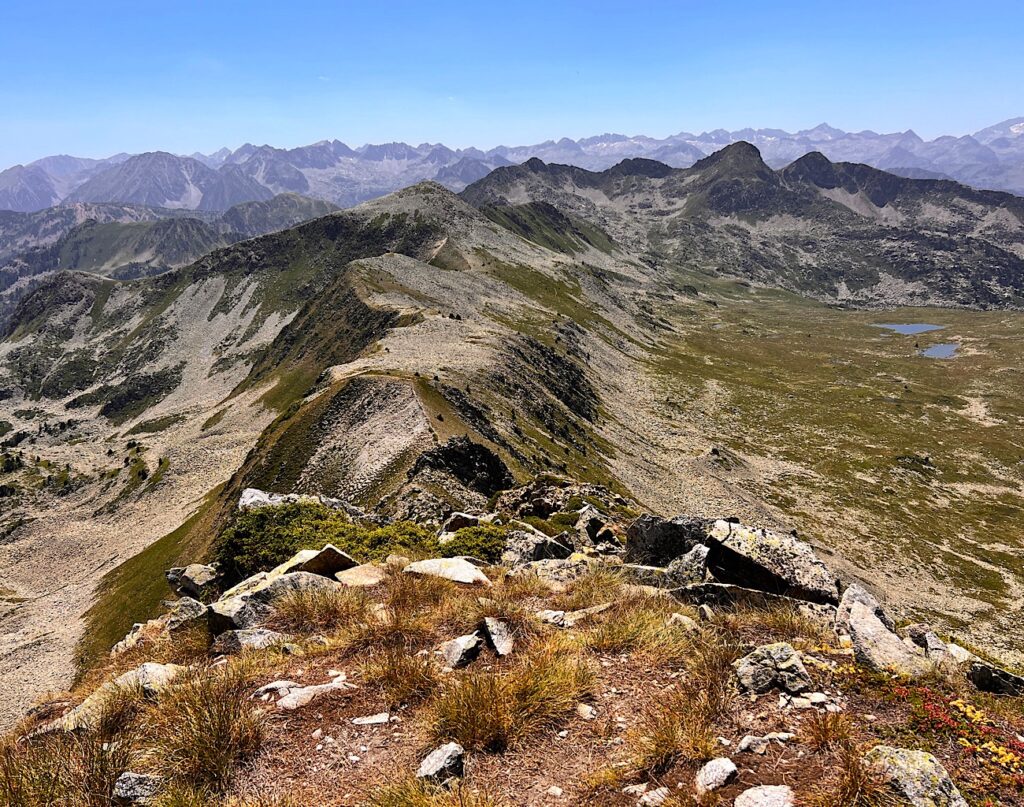
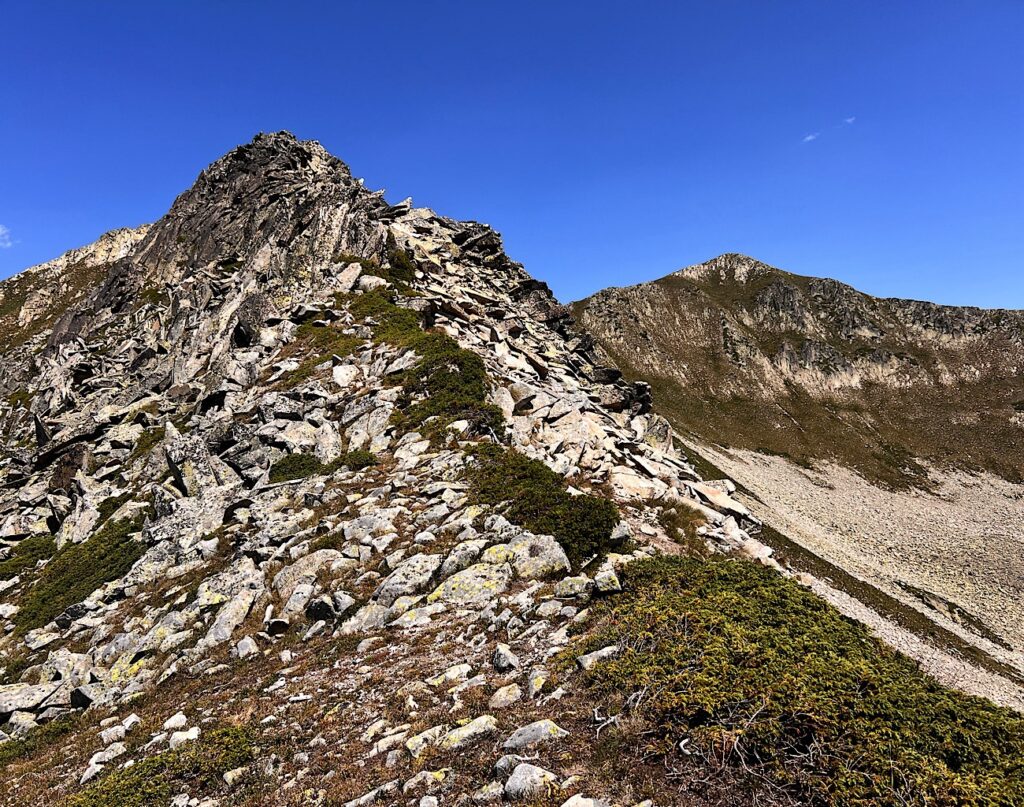
I flip back and forth between calling myself a total idiot and deciding I’m actually a problem solver. I whine a bit, then stop realizing it is not helping the situation.
I don’t walk the top, a complex jumble of rocks, rather I attempt to sidle the ridge, only to find steep exposure as I carefully traverse.
Going down looks better, but it’s steep and slippery dirt, so I climb on the rock with good handholds and finally meet my intended pass, then climb to the Tuc.
OK, that made me thirsty and tired. From here, the ridge is like a dragon’s back and I’m happy to sit snd admire the view – mostly dry and desolate now, but with Aneto and the snowy Maladeta massif looming in the distance.
Now I need to follow the ridge, much less intense but still requiring good balance and concentration. I hit another Tuc and overshoot momentarily, before realizing I need to drop into this valley.
It’s rough walking on rock and juniper but I can see the way to my final pass and begin to feel more hopeful.
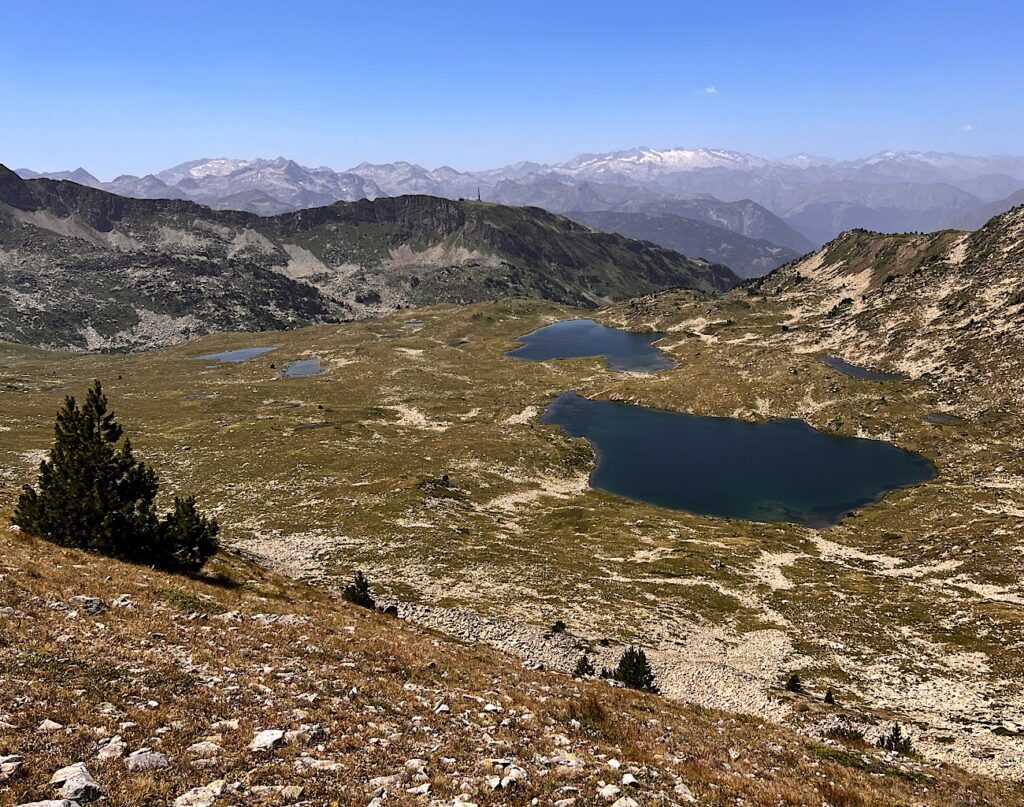
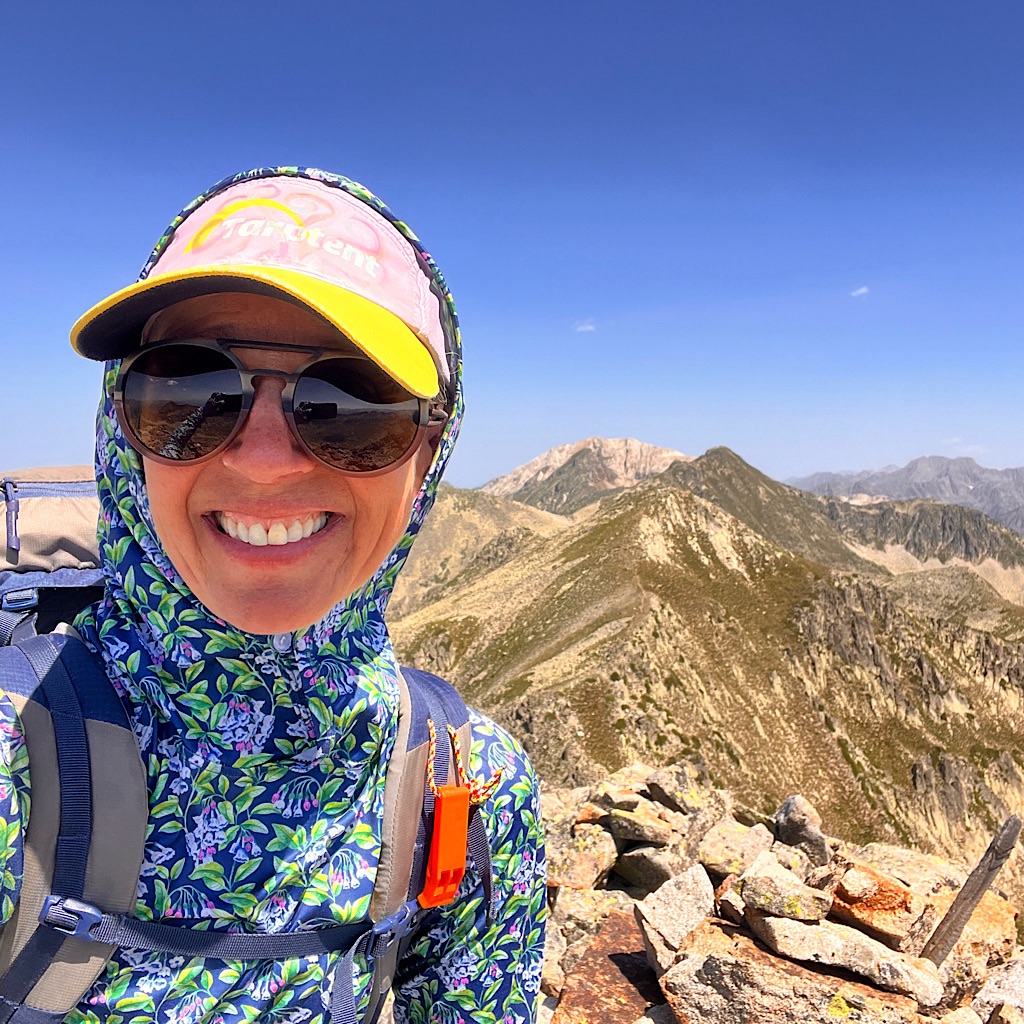
That’s until I see below what I’m up against. It’s practically non-stop boulders – a garden of granite, a river of rock, an entire valley of exfoliation – and it goes on for an eternity.
The only way through it is to walk on it. But first I detour to a tarn and filter water. It’s clean enough though crowded with tadpoles. I could just stop here, I suppose, though I’m not sure I packed enough food, and it’s only 2:30.
So I drink up then take ‘em on. I guess from here on out I’ll need to be religious about every step I take. I’m off the route by what seems like nothing, and yet it takes me into the worst of them.
At least Floris would be proud I’m taking less time to move and my balance and courage has improved.
At one point though, I scream, “I gotta get outta here!” and direct myself higher where the smaller stones reside, still a test of route-finding, core strength and nerve, but not somewhere I’ll fall through the earth.
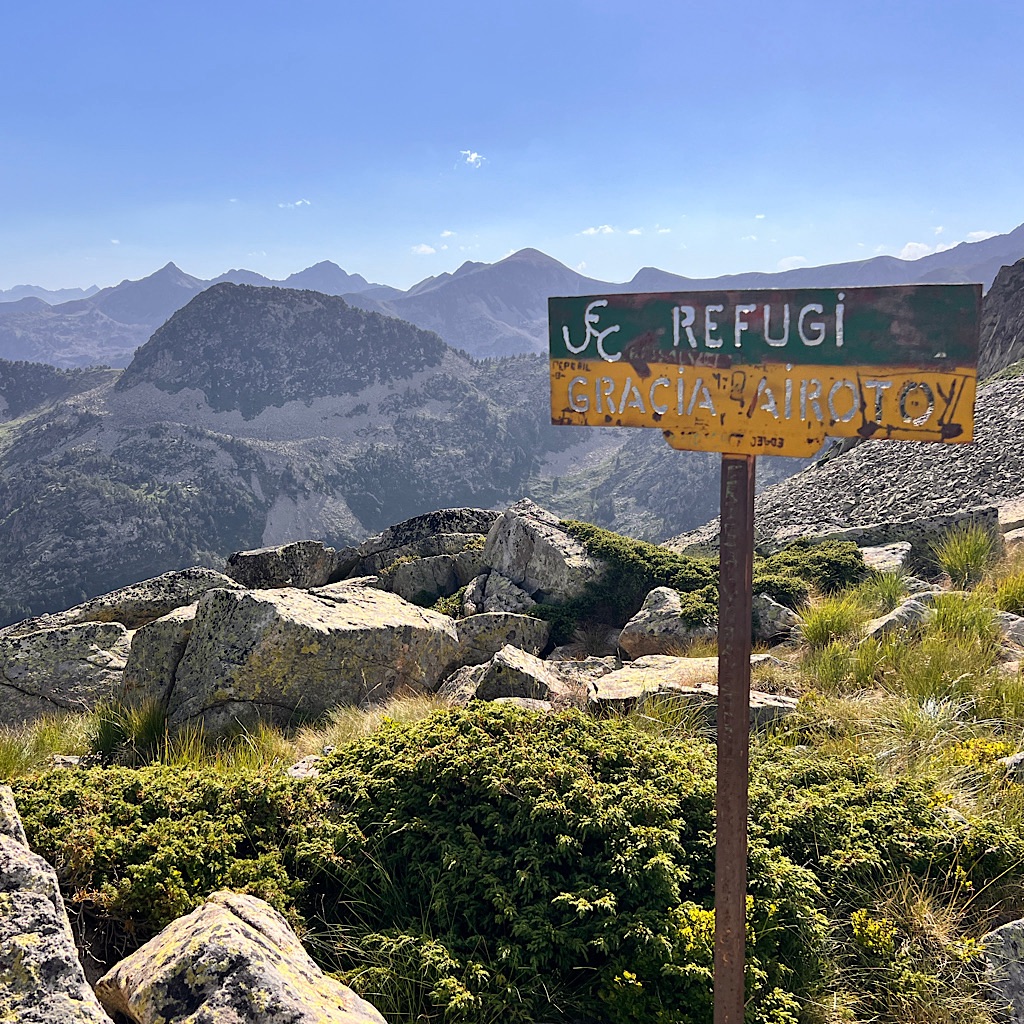
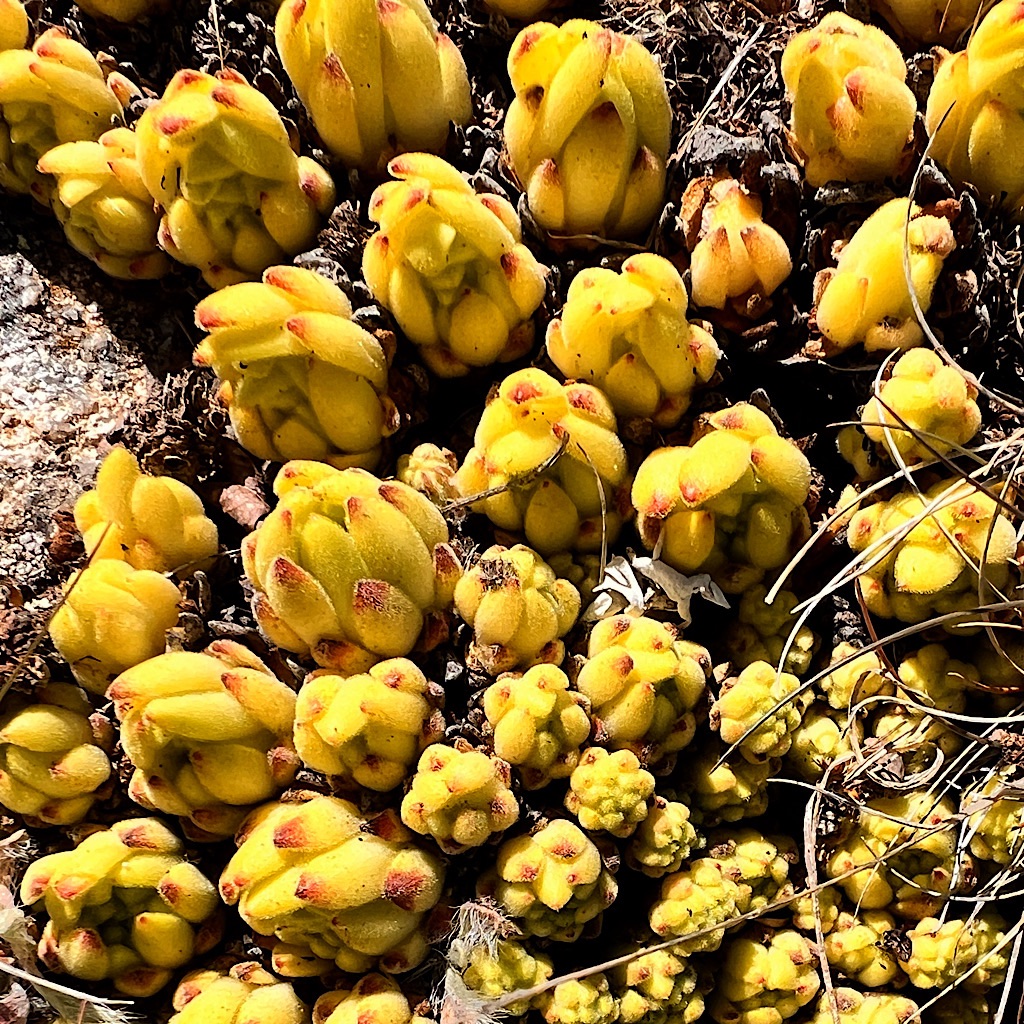
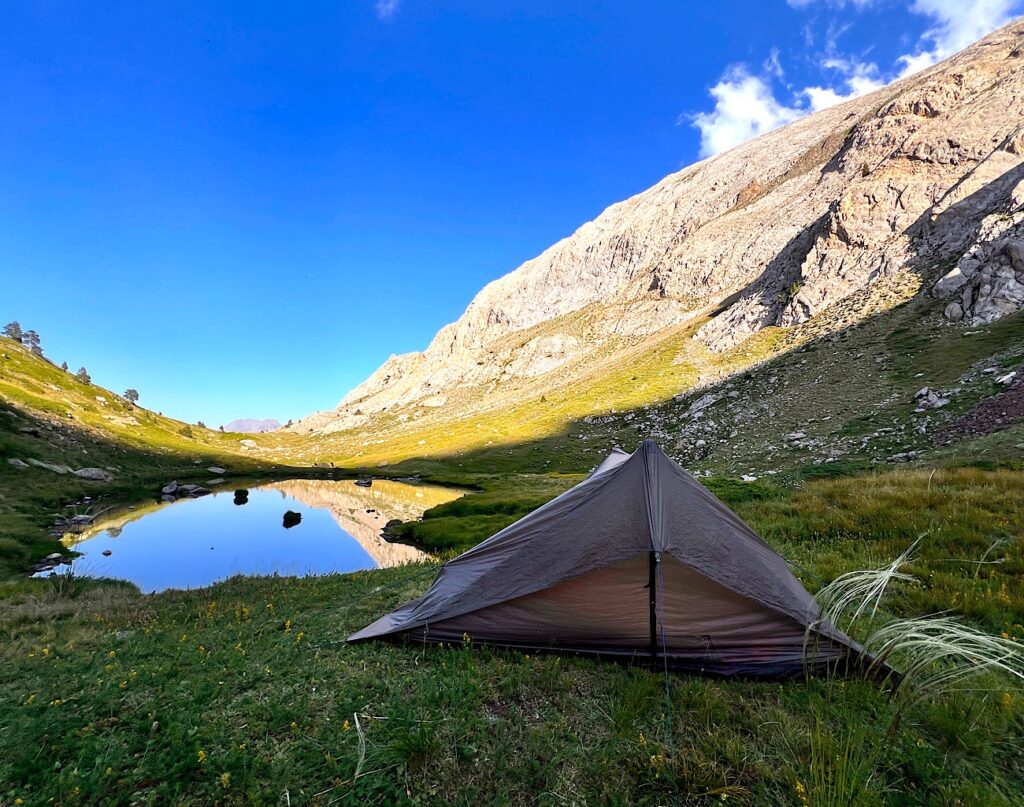
There’s a refuge below and a “shortcut” to the pass which will deliver me to a wee tarn and “fine places for a bivouac.”
The guidebook claims a trail appears and I do see a kind of ledge in grass with a fatal drop should you tumble to your right.
This is where I meet the Germans, absolutely incredulous that this is the route. I pass them, and the man follows close, but the woman slows way down grabbing blades of grass for balance. I don’t see them again until my tent is set and dinner cooking.
At last, Collado del Clot de Moredo is reached and it’s a more typical descent on actual trail.
The sky is still light, but it’s getting chilly and I am a complete and utter wreck from so much rock walking – plus unplanned rock climbing. My eyelids are heavy and I’m hoping tomorrow offers a slightly less intense version of today.
But, heck, it’s a “route,” what do you expect?!
Day Twenty-four, Estanyola del Clot de Moredo to Estany de Llavera
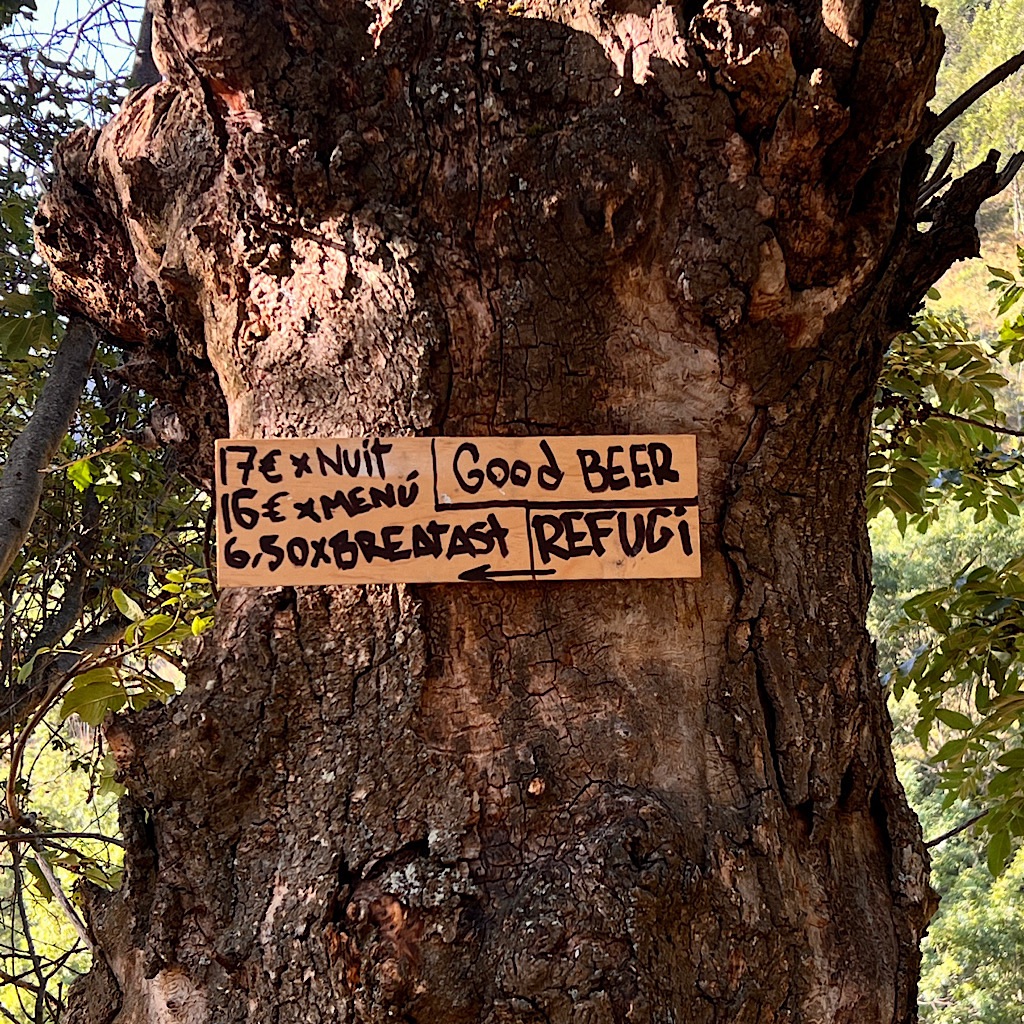
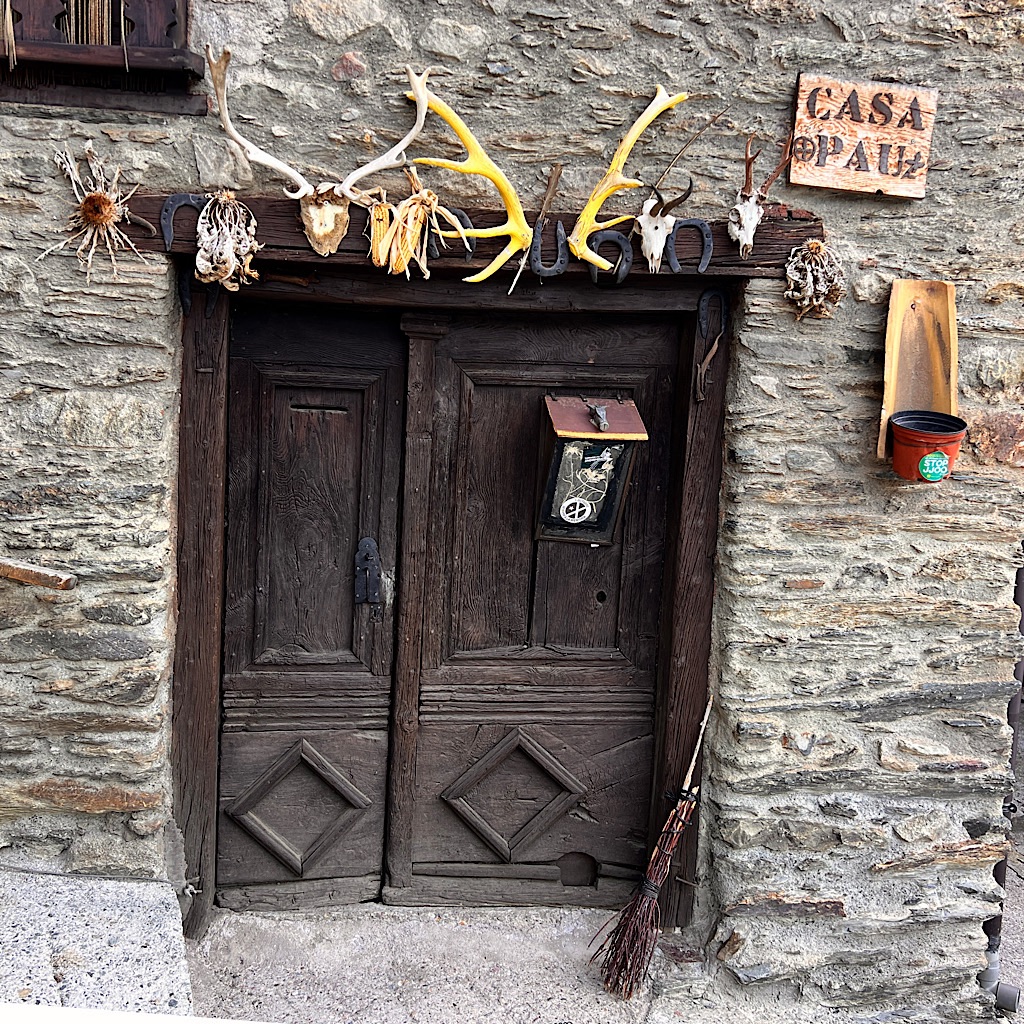
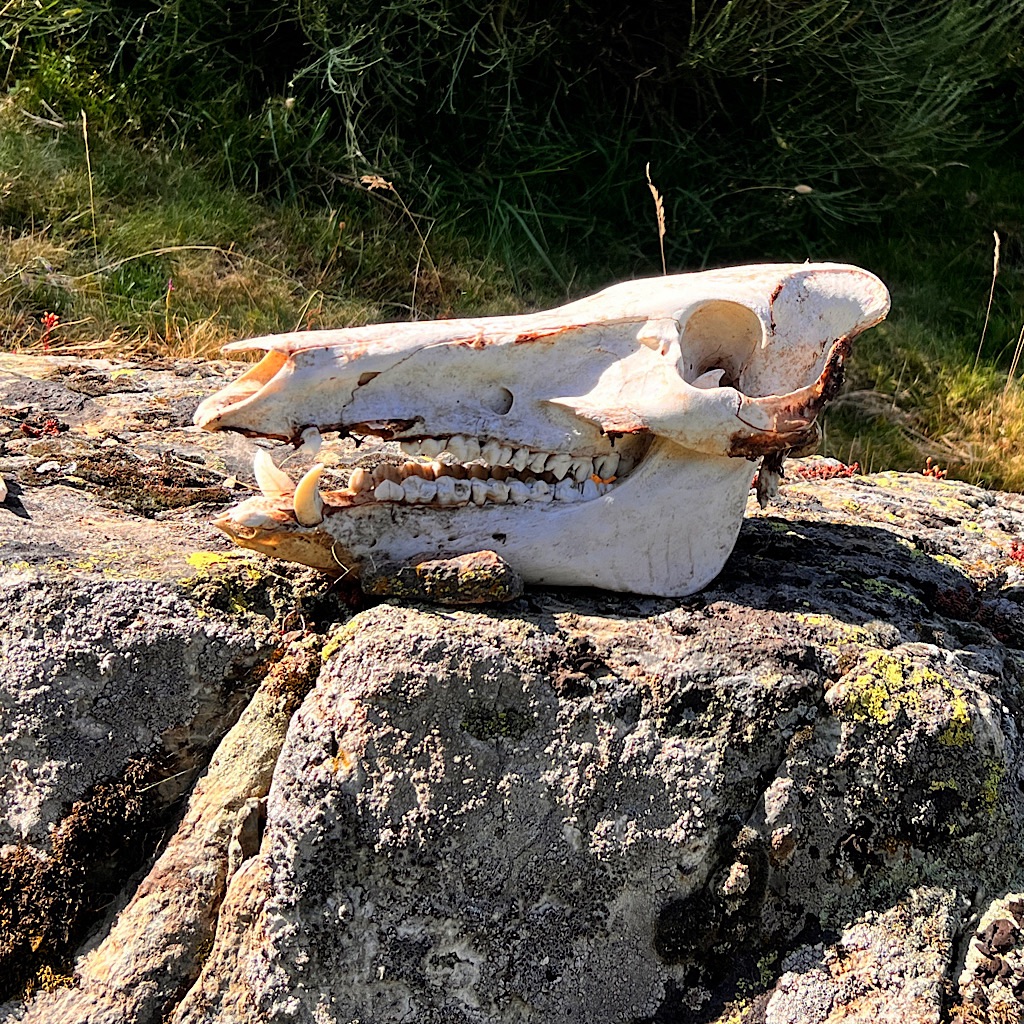
It is an absolutely extraordinary day. I’m cuddled in again before the sun is behind a peak.
My bivouac is tucked in by another magical lake. No one seems to be joining me except some cows. Above me is the unmanned Enric Pujol refuge where I score some nuts and a Chinese dinner.
It’s a metal box fastened to rock by cables with nine spots to sleep, but I much prefer my cozy alicoop on soft grass.
Funny, I had no intention to walk this far. Three cols with 1,500 meters of climbing seemed far out of reach after yesterday. I was so sore and tired, my body wouldn’t let me sleep at first – and then it was beyond deeply.
I woke with a soaking wet tent, but the sky was clear and I gathered my courage to keep moving, knowing I’d proven my mettle getting out of jams.
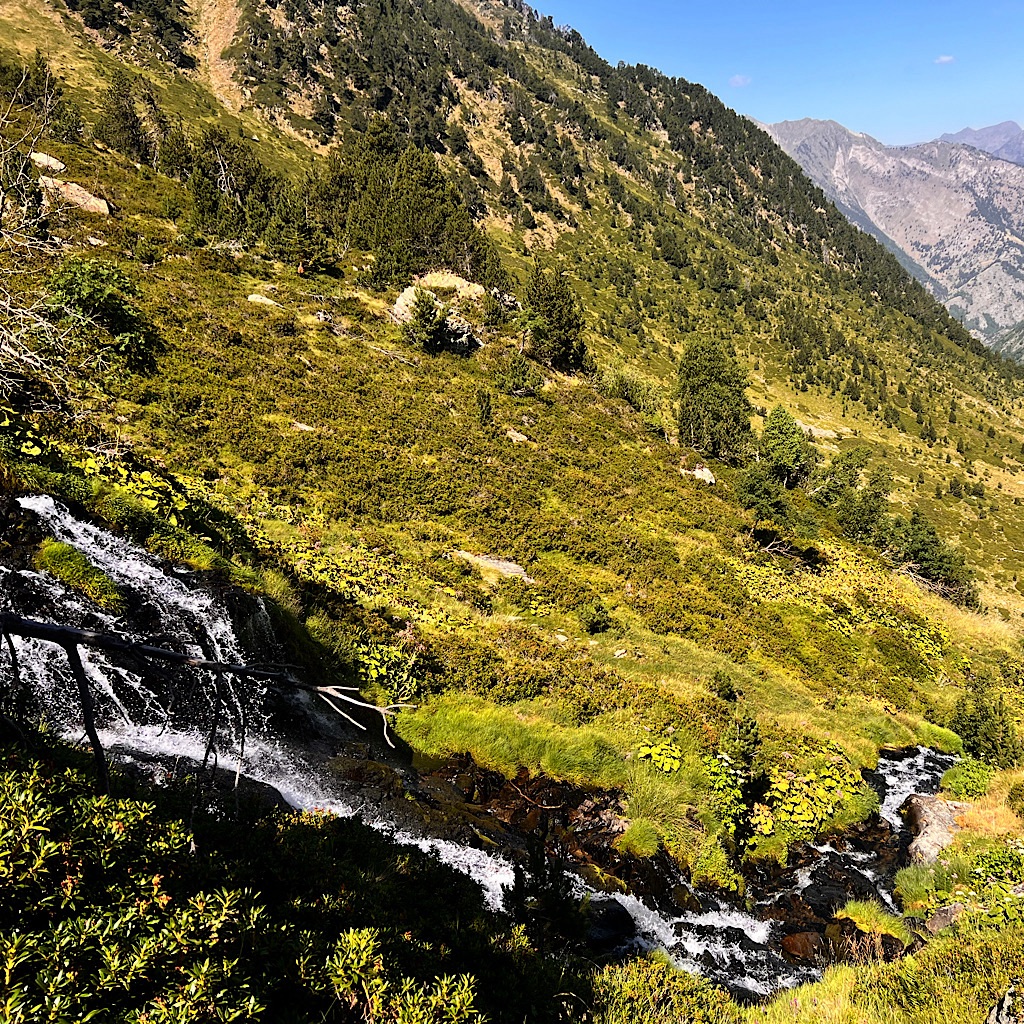
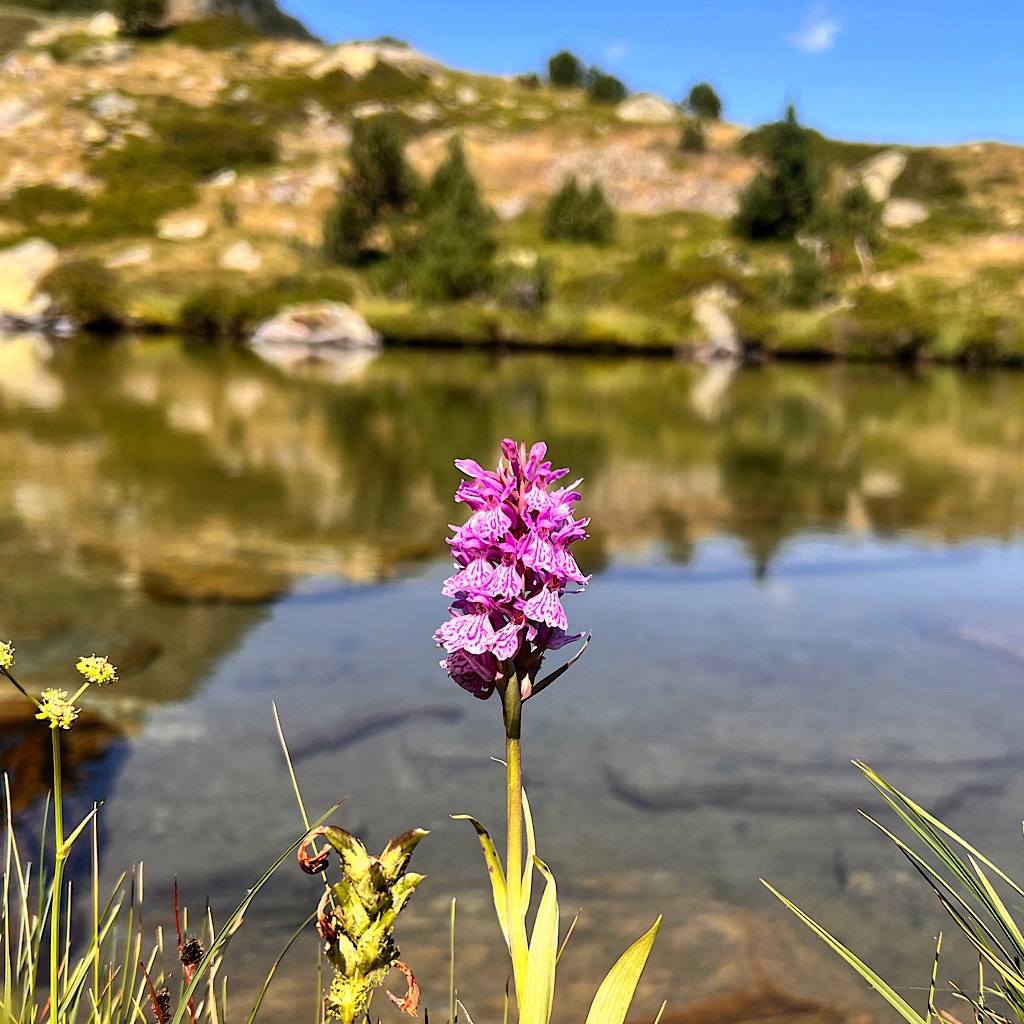
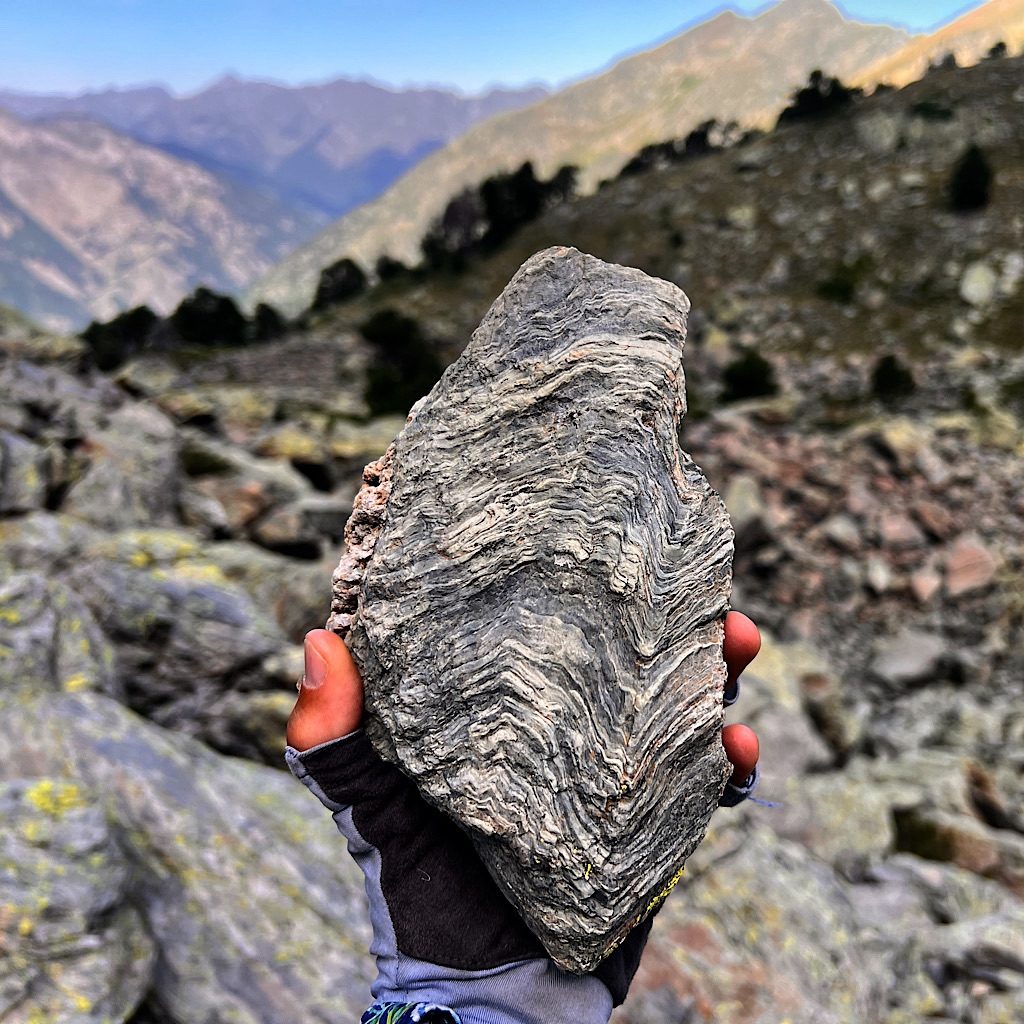
I worry about the first descent to Alós d’Isil, which the guidebook describes as “legendary” and “requiring a good deal of improvisation.”
Truth is, there’s a decently marked trail all the way down, first cutting switchbacks in a dirt road, then following a well-worn hiking trail through forest (where a deer runs up to me on trail to check me out) and straight into town, but not before being promised “good beer” from a sign nailed on a tree.
Perhaps I should have kept walking last night.
Truth is with or without improvising, it still takes me close to the forecasted two hours to descend – and without a need for beer, I walk up a road to reach my route back into the mountains.
I had planned to camp at a small lake, but it’s so early and I’m feeling relatively good, so I consider crossing these cols. Besides, there are other lakes on the way should I desperately need to stop.
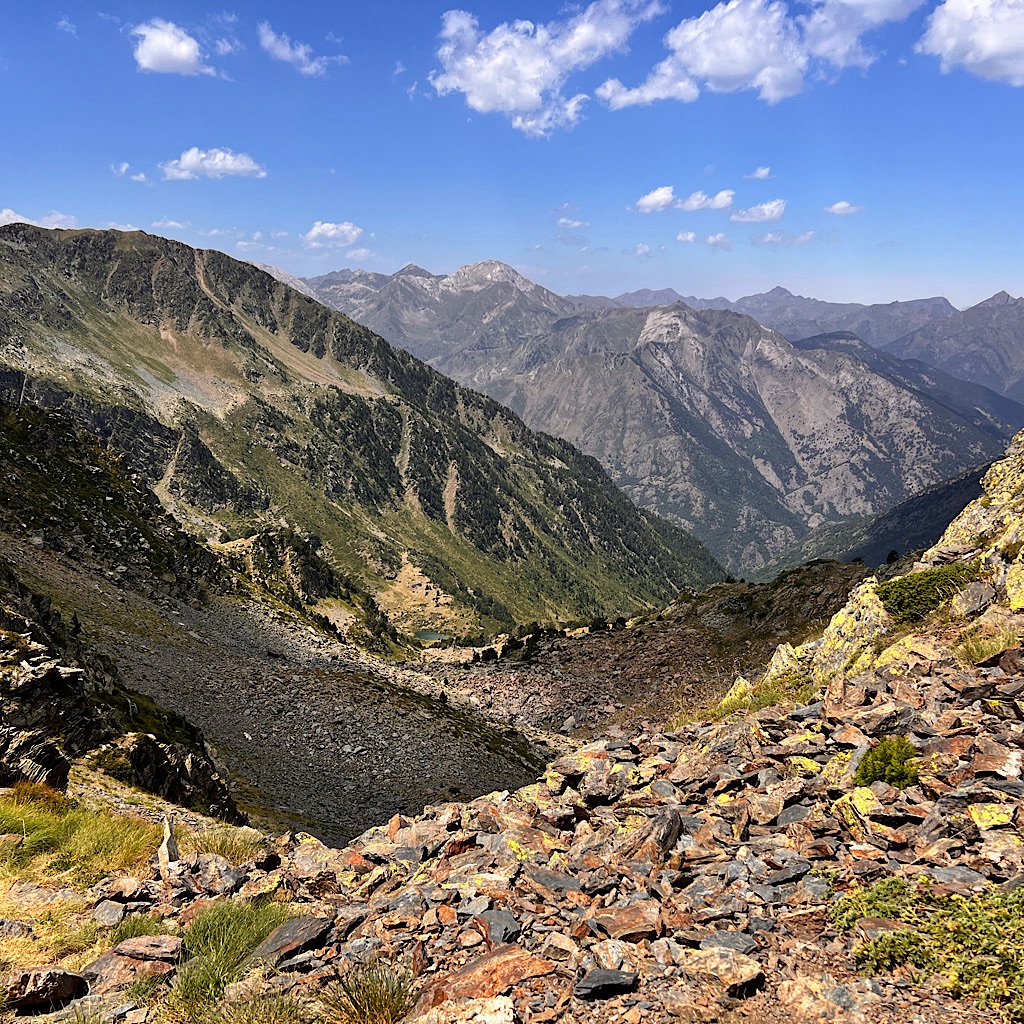
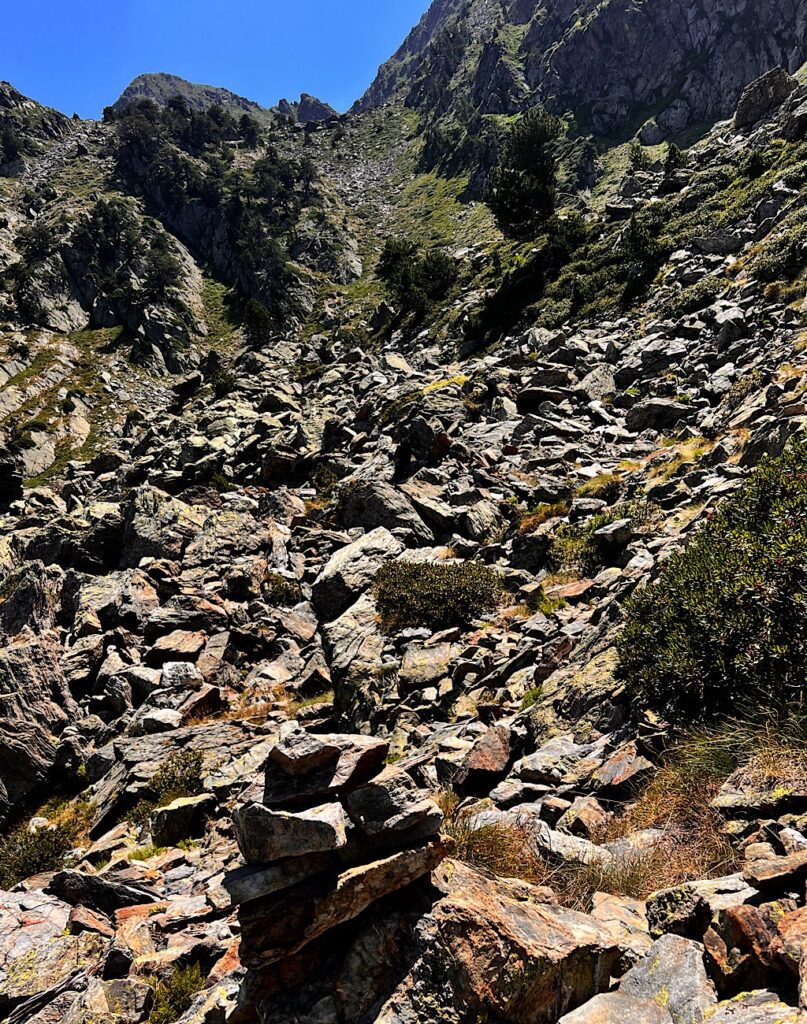
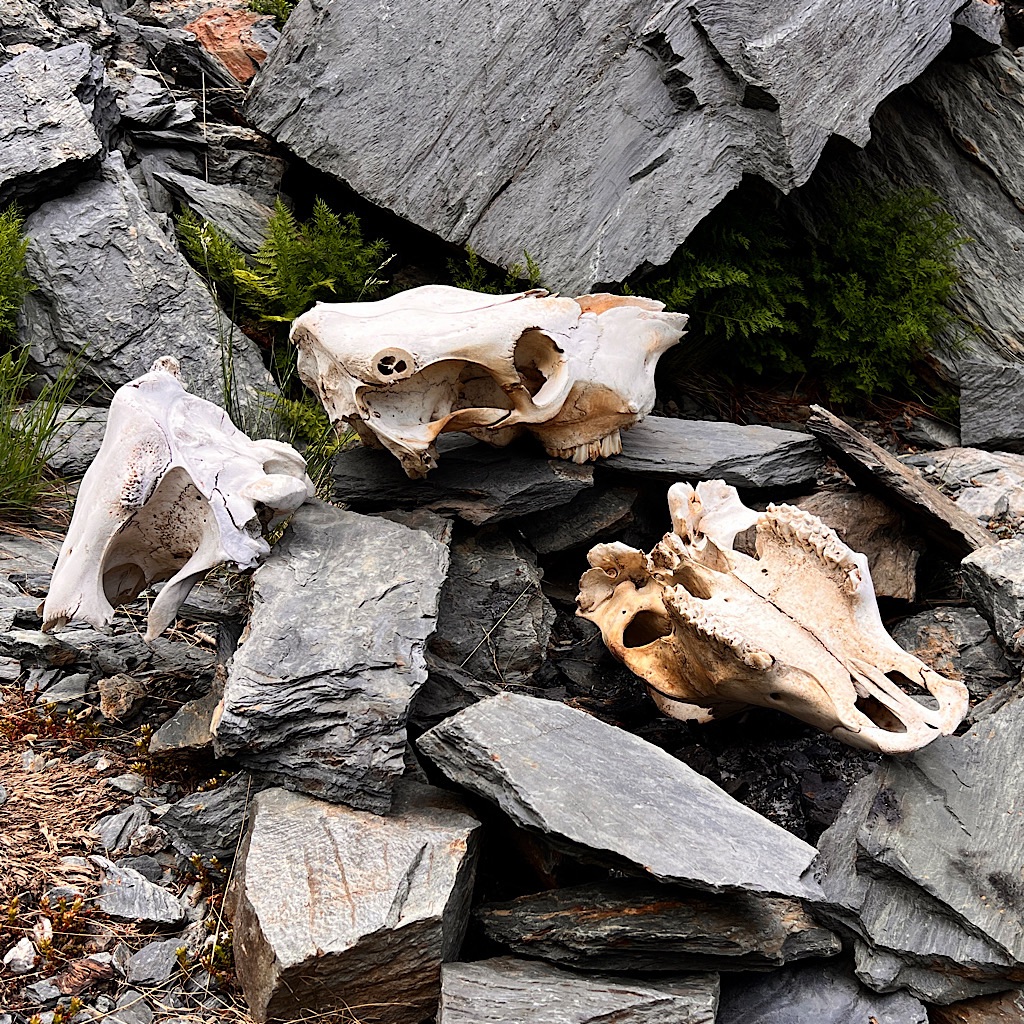
According to the guidebook, it makes today a nine-hour walking day, so let’s see what happens when we add steep uphills.
I leave the main road, where several bicyclists pass me, for a dirt road, and begin climbing steeply, first past farm buildings, then on a trail that crosses several streams.
I make sure I drink plenty of water and keep hoofing up through forest that gets prettier and prettier. Huge mountains loom above fairytale meadows.
At Comamala Plateau, several waterfalls and cascades converge into clear streams. I could simply live here forever.
Above in a hanging valley is the tiny lake where I’d initially planned to stop. I climb next to the falls and come to a bowl of rock and grass.
I find a rock shaded by a small pine. The wind hisses through the needles and crickets twitch in rhythm like a summertime sprinkler.
Frogs leap into the water from grassy humps curling over the bank as I pass. My rock is dotted with electric green lichen and small gardens of opportunistic flowers.
I stay a long time here drying out my tent in the sun and eating lunch. It’s so alive yet peaceful. All I can think is I could live here forever.
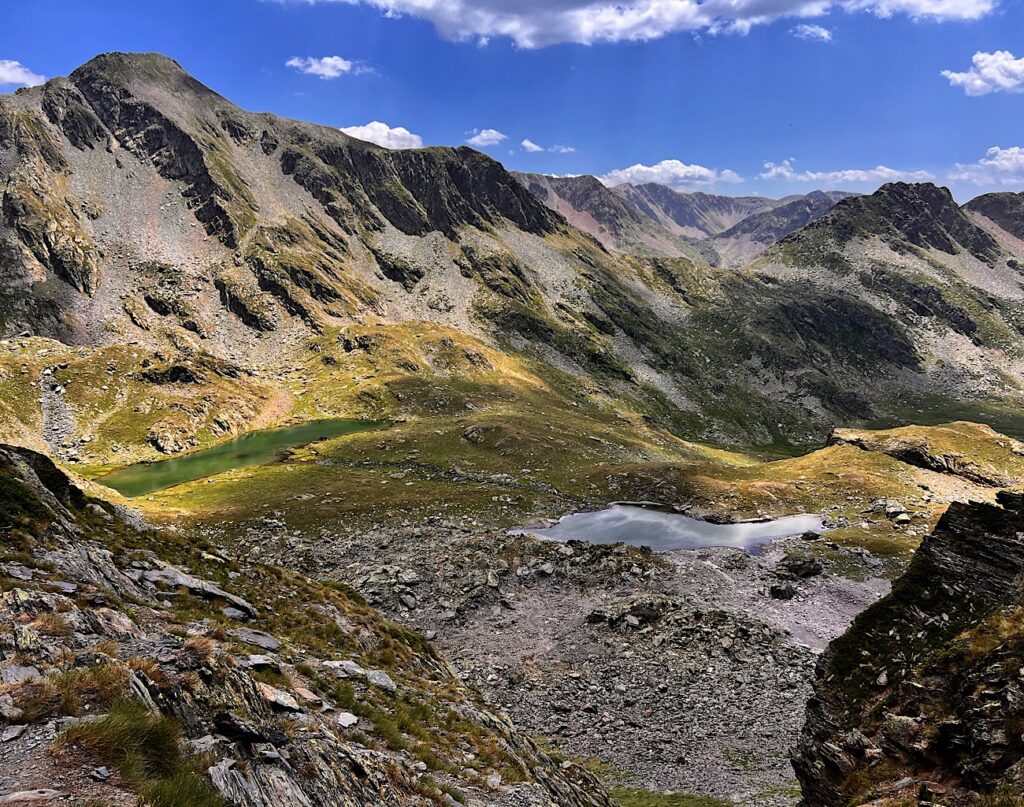
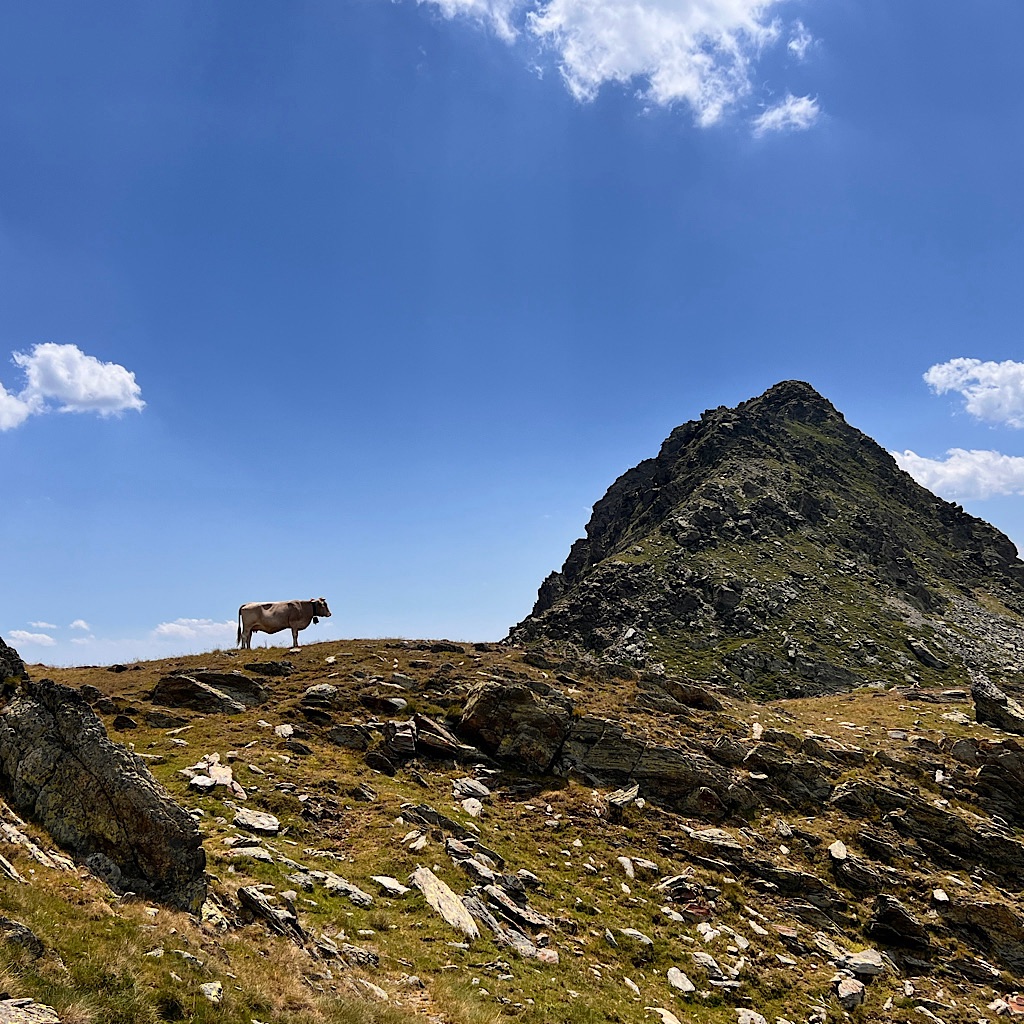
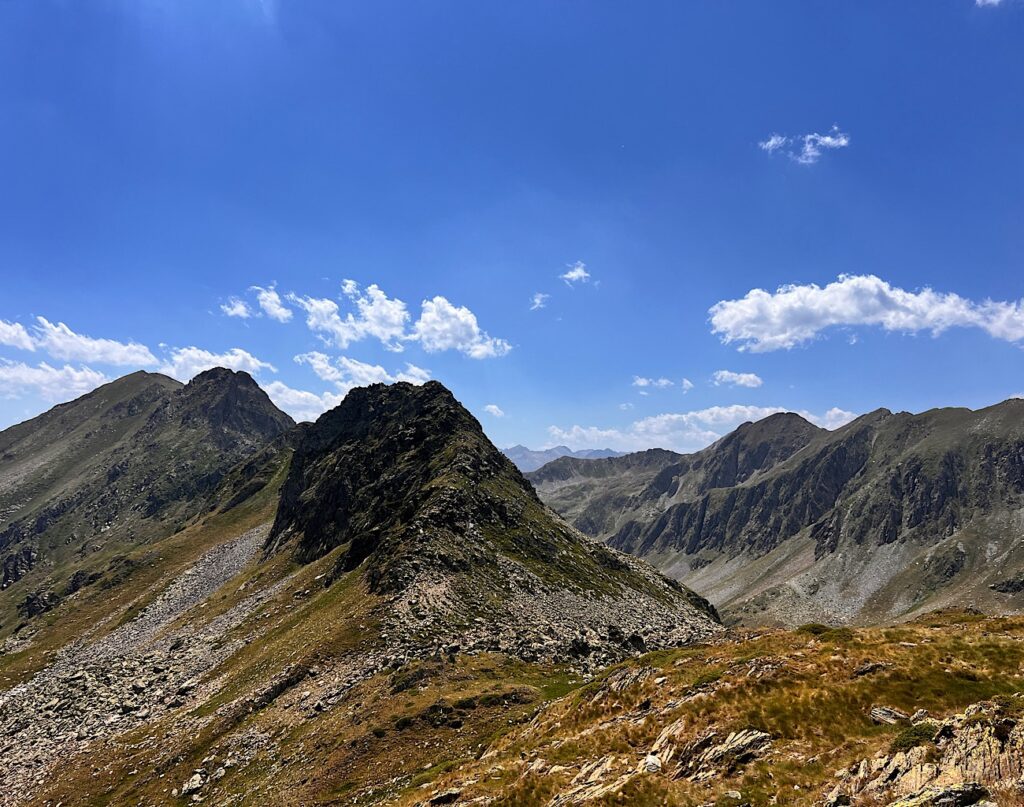
But it’s only noon and I have all afternoon to tackle my three cols, plus stop and soak it all in on the way.
The first is Coll de la Cornella, a 400 meter straight-up climb with two false cols on the way.
It is steep this one, but sweet to look back at my tiny lake. The path is well-marked with cairns – now why couldn’t they do that for yesterday’s climb? – and leads me on crackly slate to a plateau with a boulder field.
Again cairns suggest the best way to negotiate this granite chaos and I’m across quickly, climbing again to pop over into another plateau, a very creepy plateau filled with bleached cow bones. Someone has arranged three skulls in a kind of artistic triptych.
I’m out of here quickly since no water, only bones and climb again on tight switchbacks to the tiny hole of a pass.
The guidebook warns to descend carefully on an “extremely steep scree slope,” and he’s not kidding. Each step is taken with care (or on my ass) as I slowly ease down ballbearing rocks on dirt, never trusting rocks to be solid.
There’s no real exposure, but a fall could break a bone or injure a tendon meaning game over, so I inch down, bit by bit finally reaching two giant lakes in a valley with cows. These ladies do seem to be everywhere.
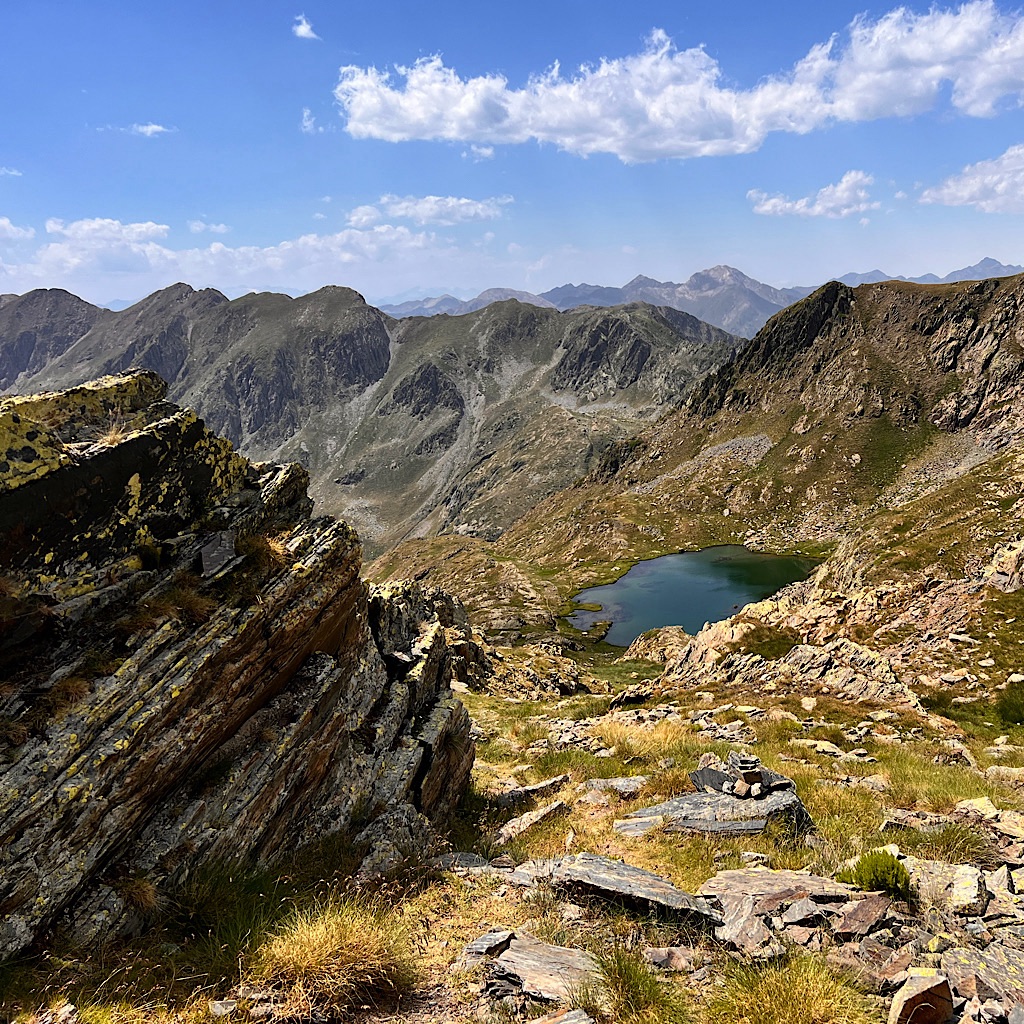
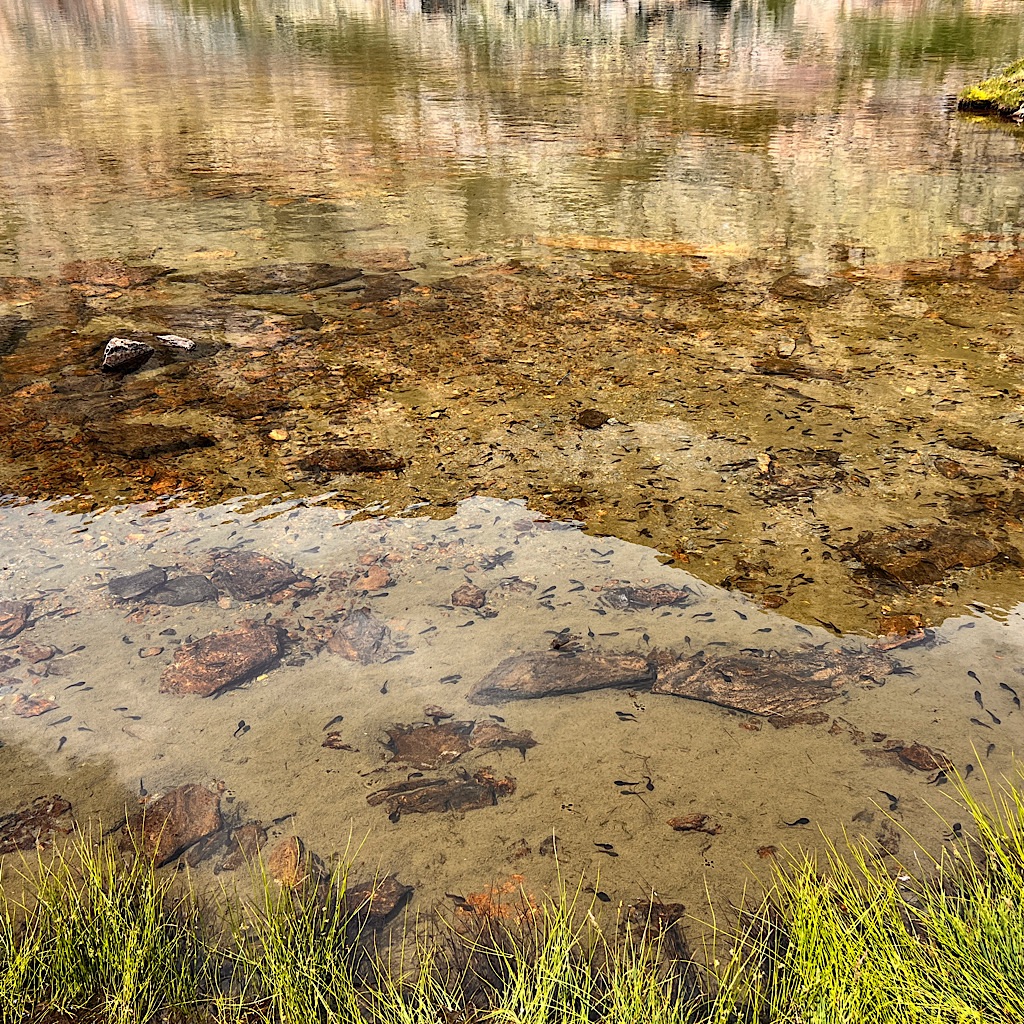
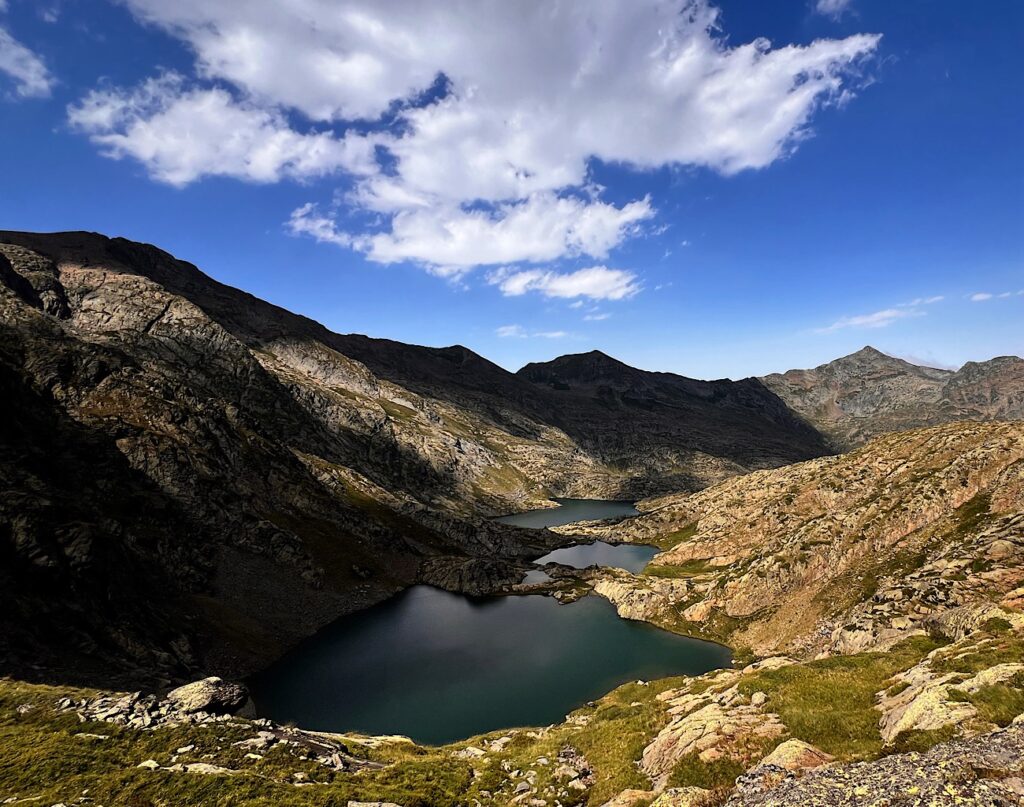
I find another lovely spot to sit and admire the wild, vastness of this place. The mountains are craggy with bits of green. No snow here and fewer wildflowers, though loads of water.
A marmot screams a loud warning and I jump. He’s so close and that scream is unbearably loud. I guess it needs to be to be heard.
I could simply climb the pass from here, but for some reason, the guide has me take a circuitous route. It does afford me the chance to look back at my pass, just a tight hole with scree pouring out.
Col de Curios is not far and I climb quickly, noticing a cow has placed herself right on the wide ridge. She looks, well, ok, not majestic. Large is what she looks like. Large and iconic, her profile against a blue sky surveying all below her.
She barely moves when I pass, only giving me that long-snout, soft, sticking out ears and velvety lashes look. “Pretty girl!”
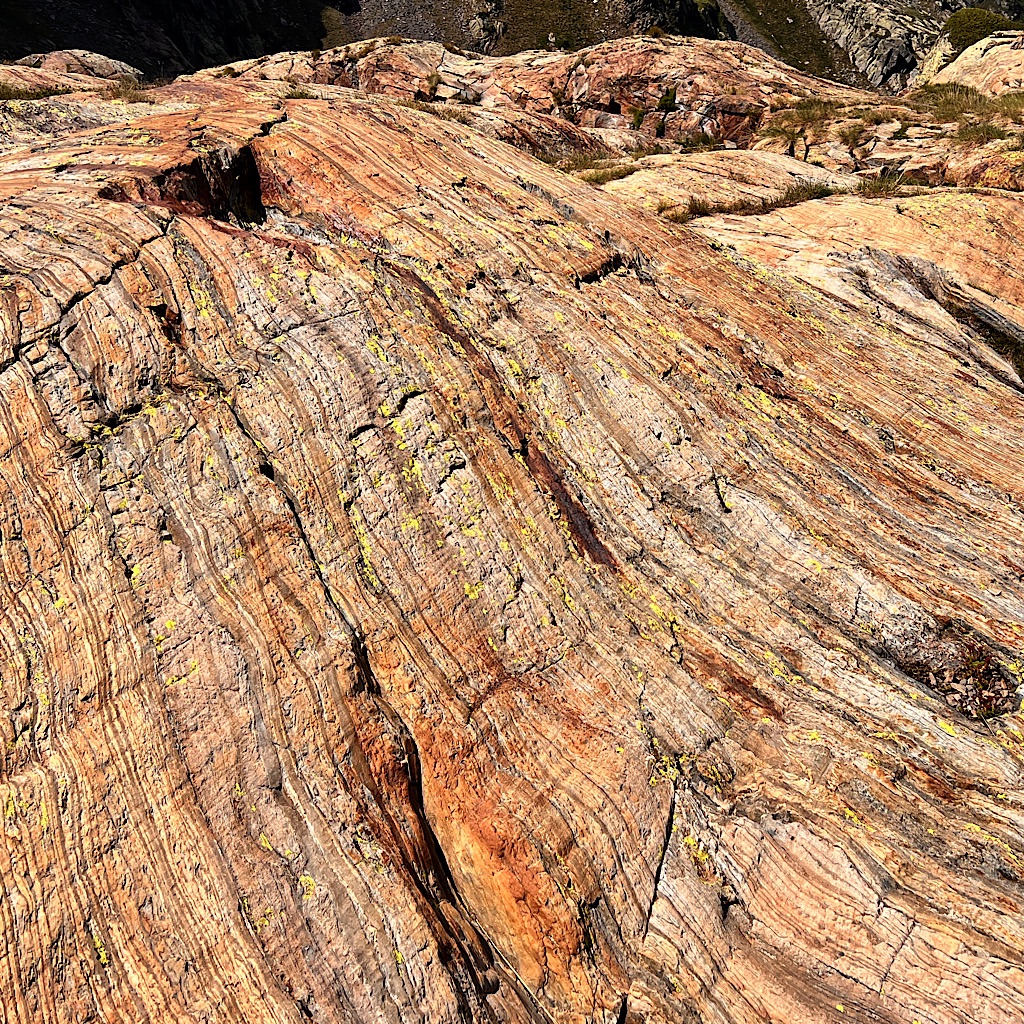
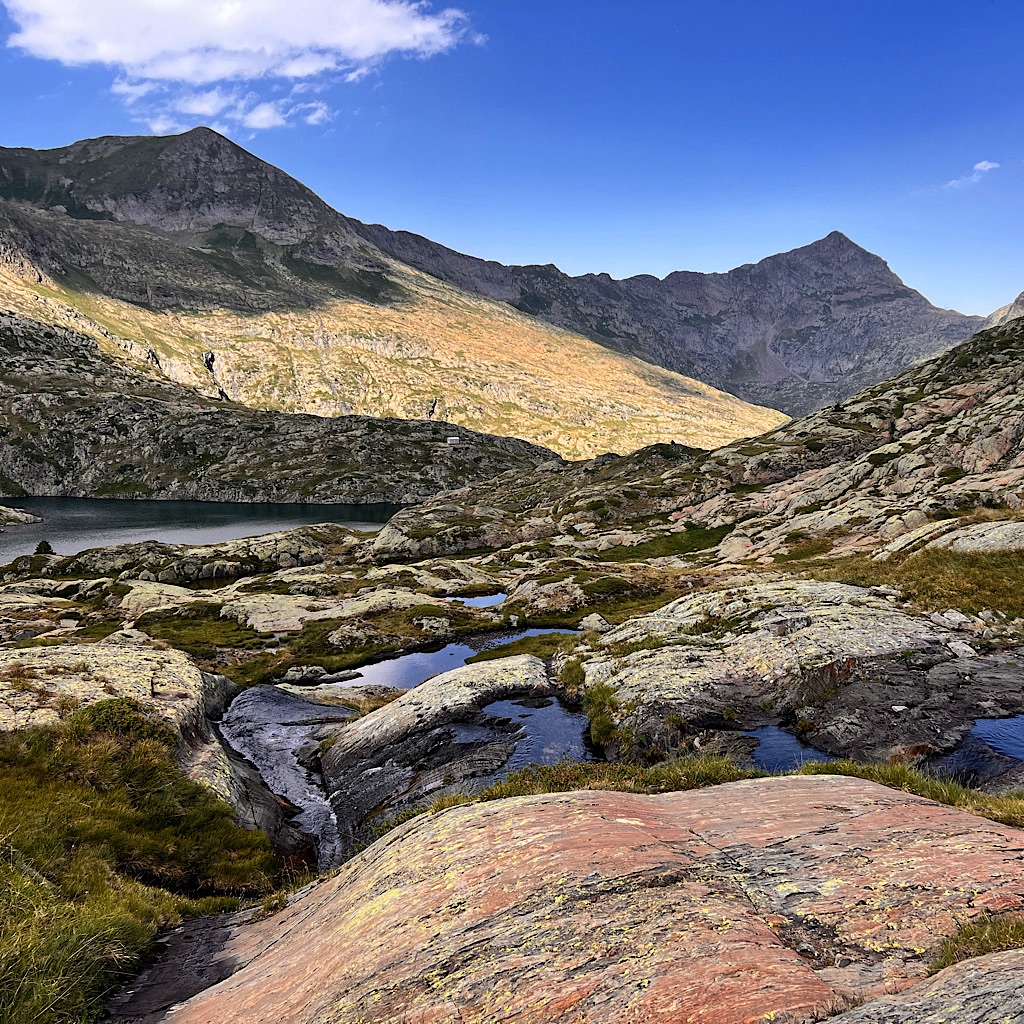
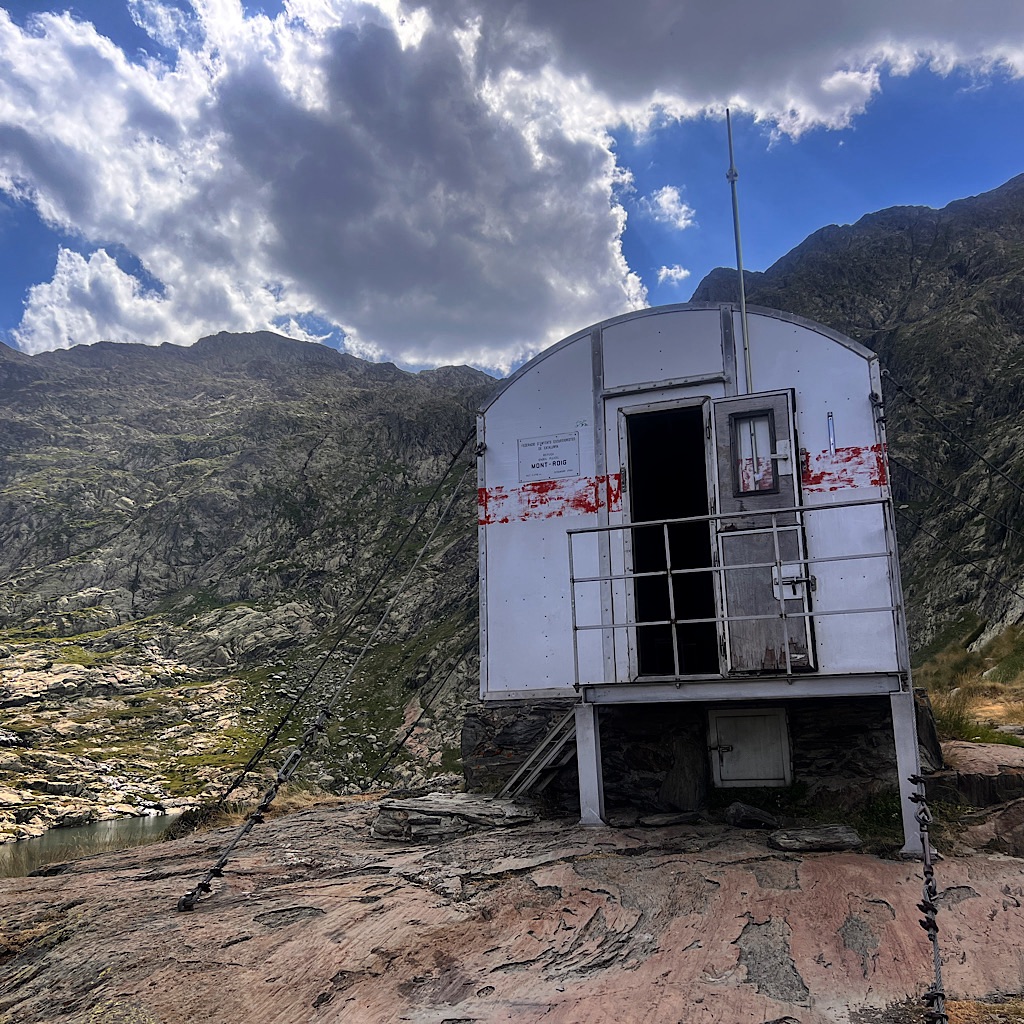
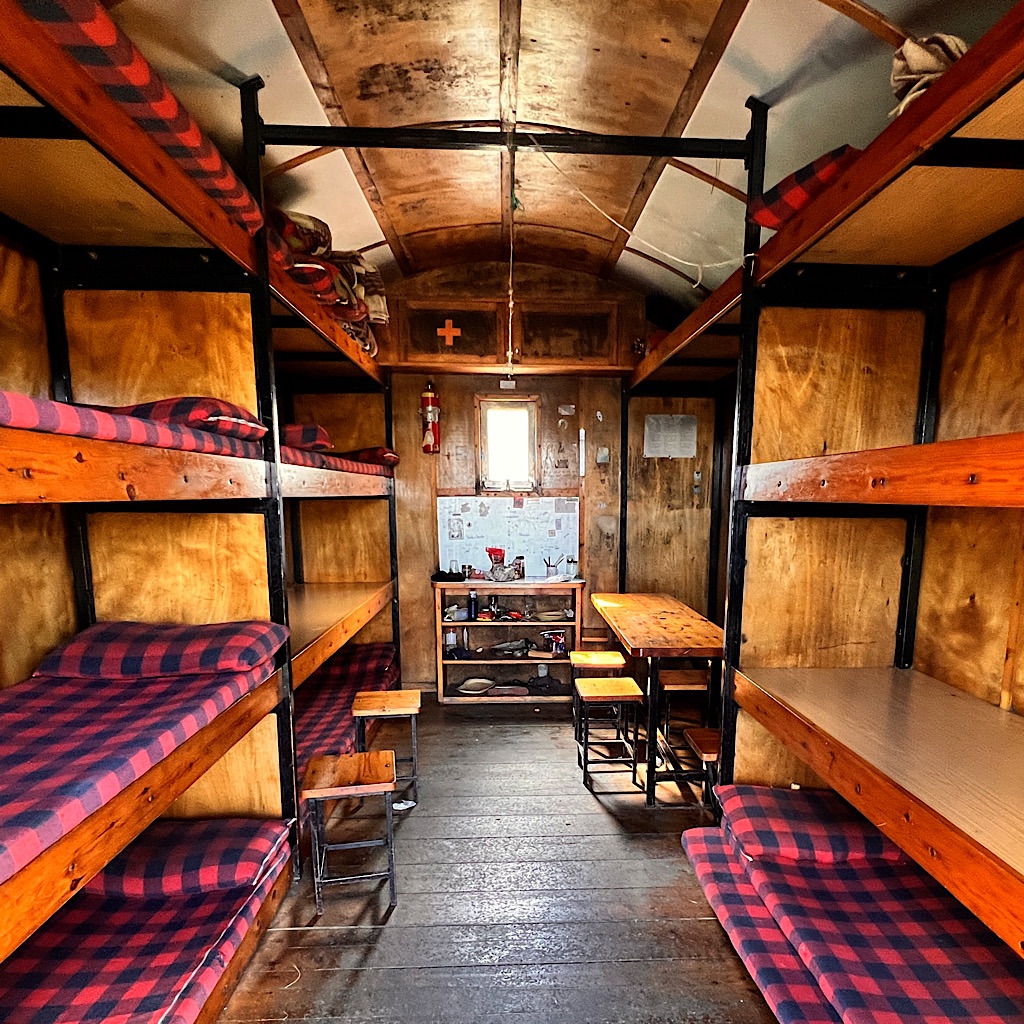
More lakes rest in a bowl below and I stop again on a rocky perch to admire, only slightly hire than Miss America Cow.
Water is pouring out of another wee lake making perfectly arced cascades for me to catch in my water bottle.
Coll de Calberante is the last and I can see the summit sign easily from here. I guess I haven’t mentioned that I move well, but my body is so tired from yesterday still, my legs feel leaden and heavy.
I pull off the gas and move slowly up, admiring my view as it changes. And then, I’m over and the cols have been crossed!
The new valley contains a large concentration of red-tinged, polished granite. Much of it was smoothed and shaped by glaciers, now providing a new color and texture for my feet.
I drop to another estany or lake, a deep cerulean, then drop again to more lakes tucked into this granite wilderness, the white box of the refuge just a tiny speck from here.
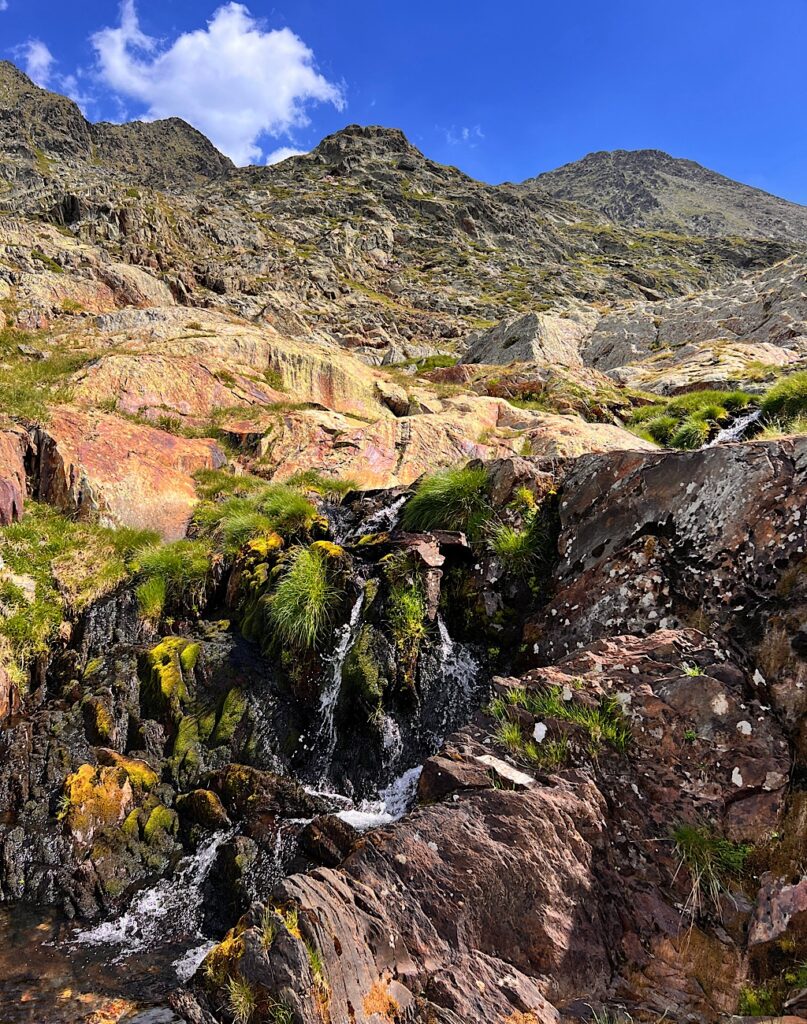
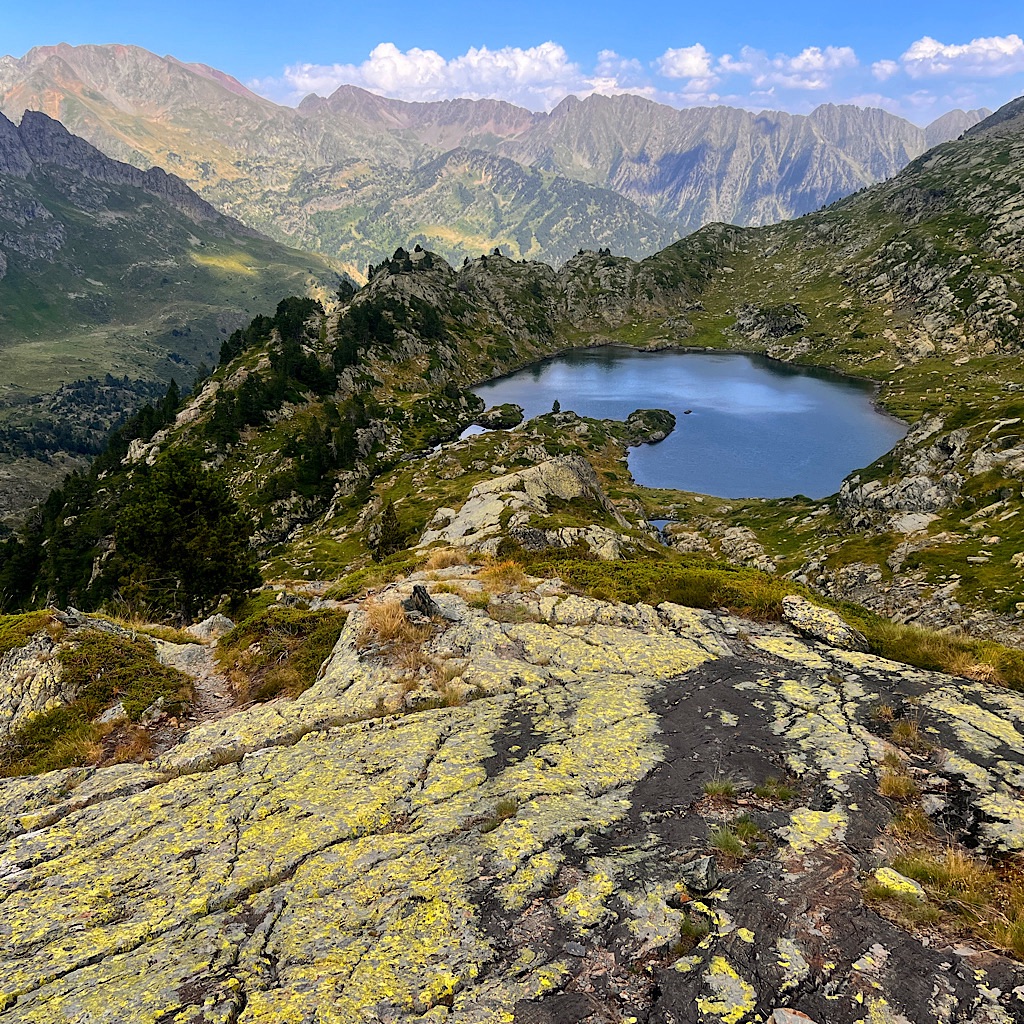
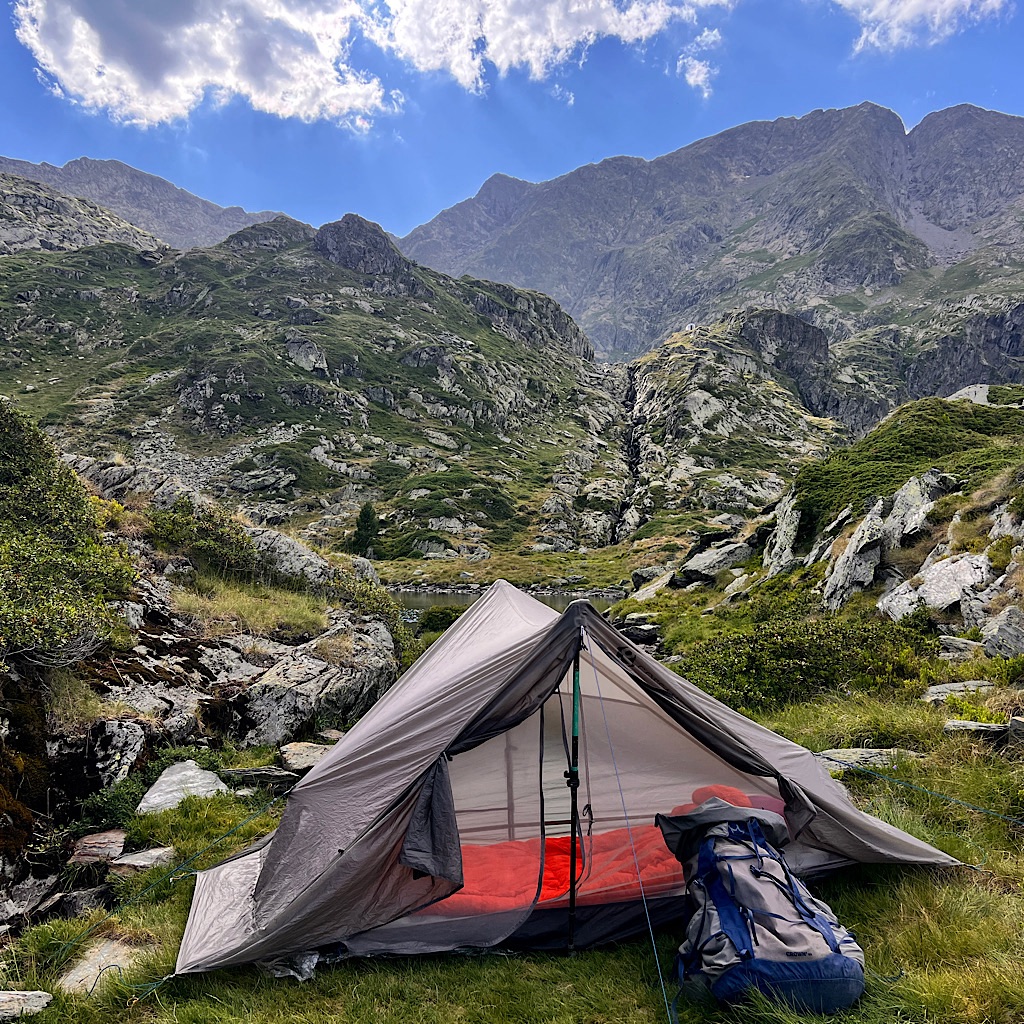
All the way down, water follows me in falls, rapids, cascades and streams. I gather some more and park in the soft grass to admire this place.
Only a mile descent, but slow as I drop down rocky ledges and carefully walk along the smooth stone.
I arrive to an empty space, then see yet another lake just beyond and claim my spot where I’ll be dead asleep soon enough as fingers of mist creep over the high passes into my valley.
Such a thrilling, yet hard day with glorious scenery. I was so shaken by yesterday, I could barely take that first step, but am I ever glad I did – then calculated I could take it all in today.
Doubly glad I did because tomorrow calls for thunderstorms in the afternoon.
Day Twenty-five, Estany de Llavera to Refugi de Certascan
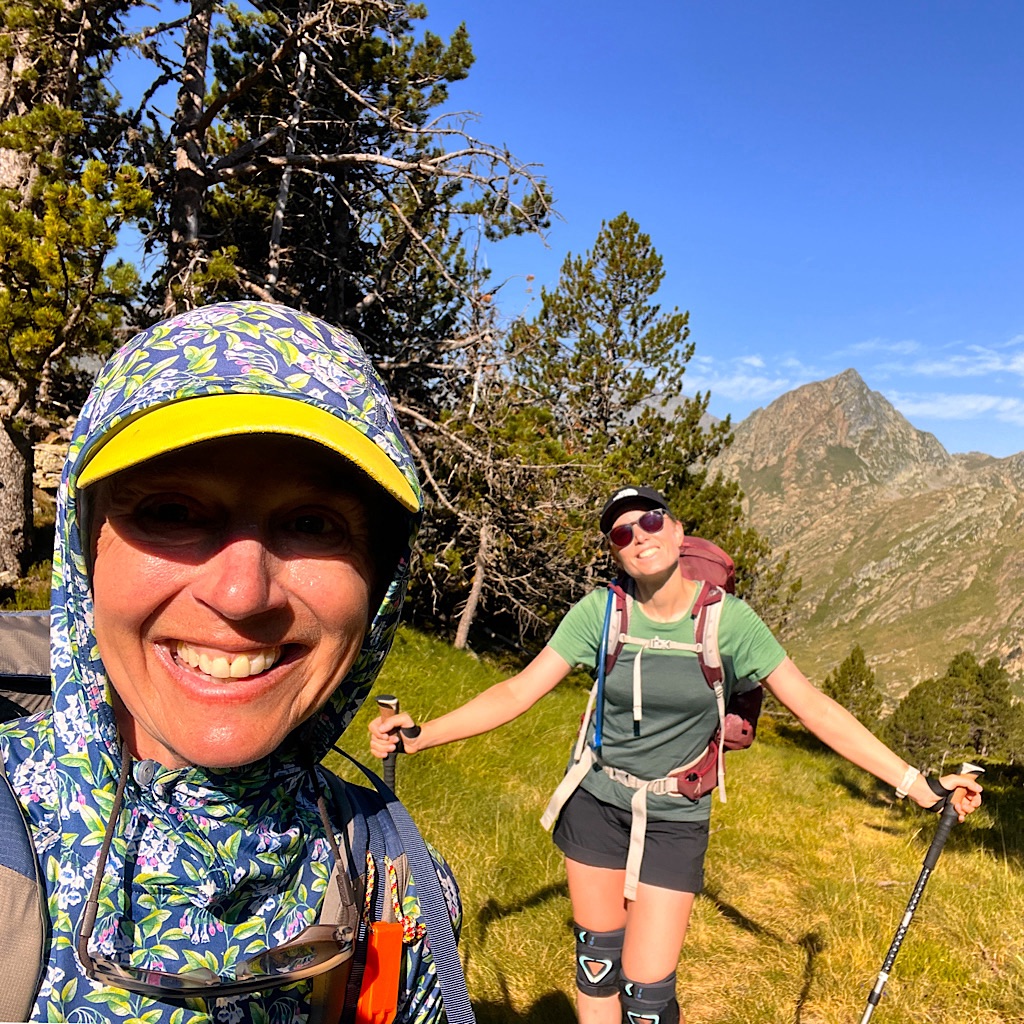
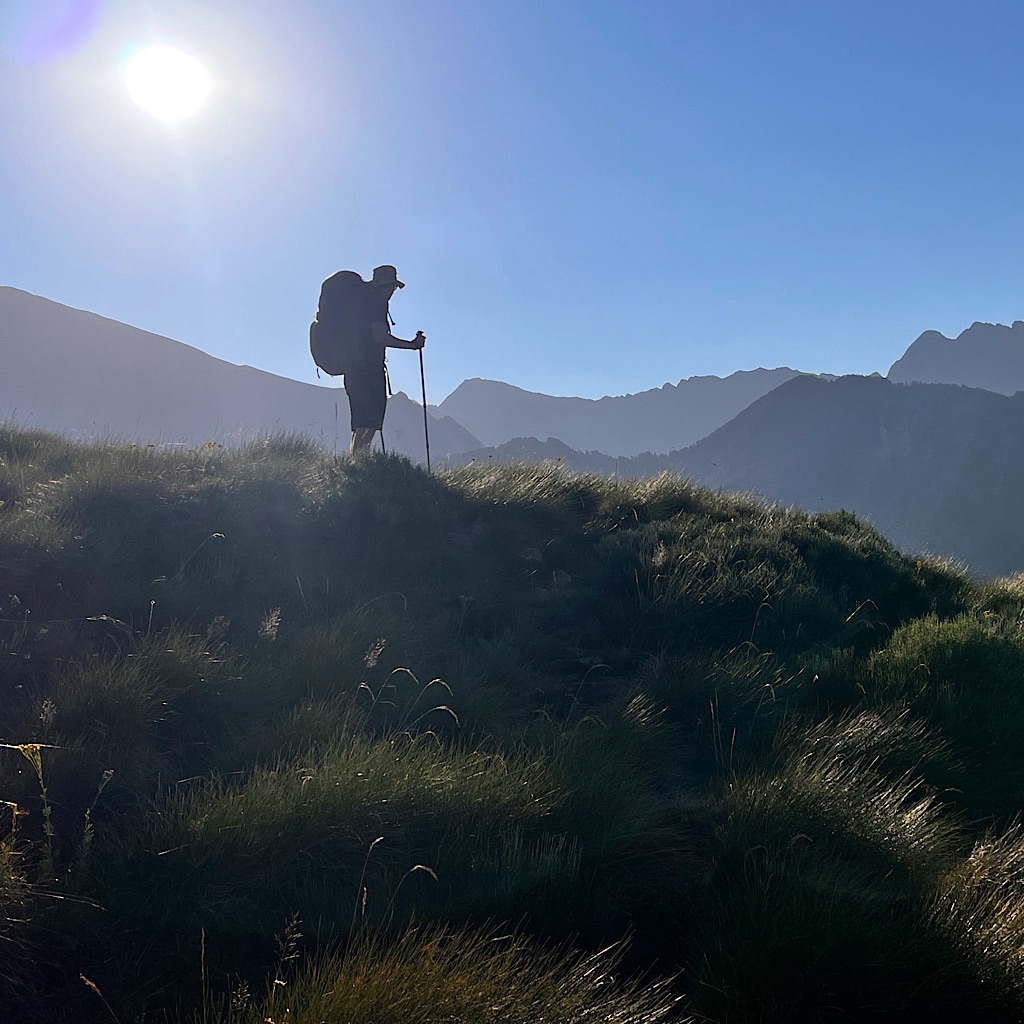
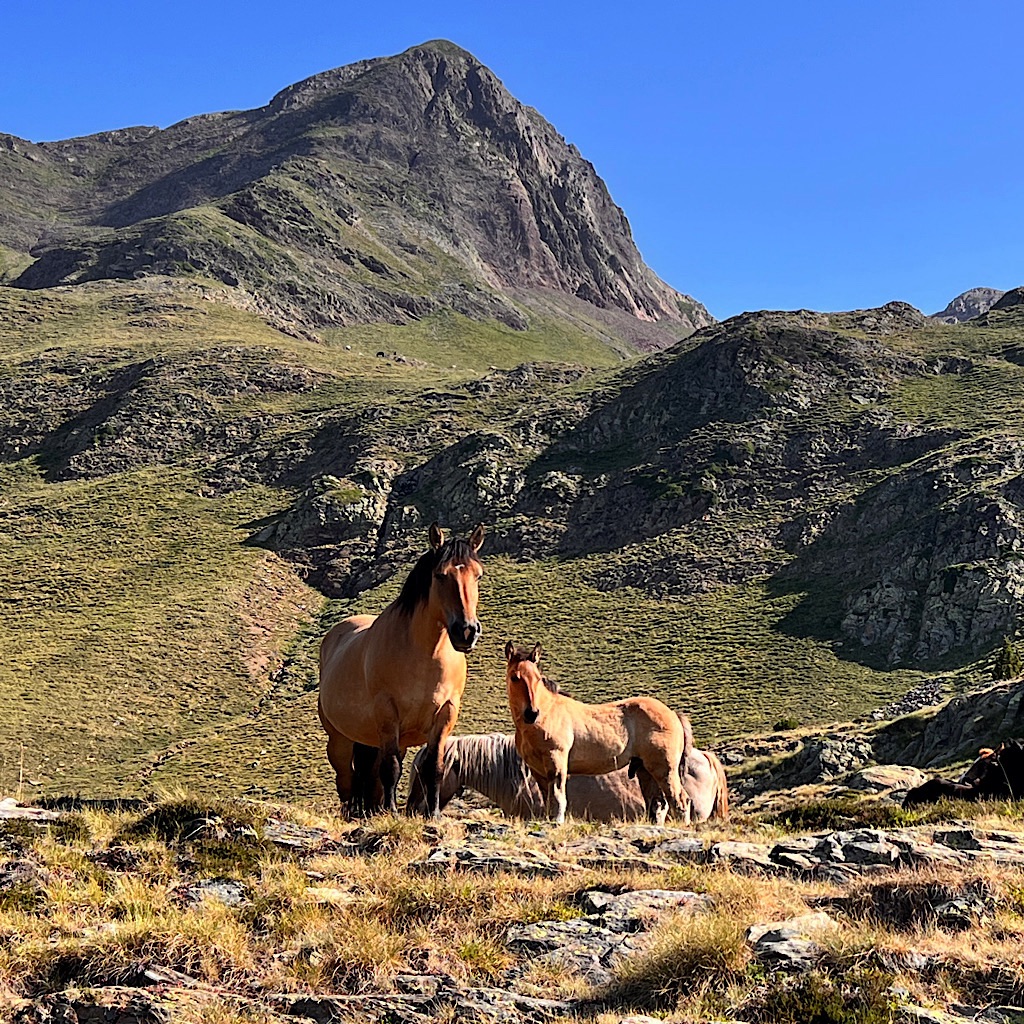
I knew the storms were coming.
Maybe it would be like all the other days and show up at 6.
Or maybe more like the actual weather forecasted, which said 3 – and then rain all night.
I didn’t have s concrete plan, but a hot meal at the first manned refuge of this section sounded like a good idea to shoot for. And if they had a place to sleep out of the rain, all the better.
And getting an early start might allow for me to bag one more small peak before all hell breaks loose.
But this morning, totally calm by my wee lake with a pink sliver of moon setting as the sun rises on a cloudless sky, I doubt the forecast entirely.
Pretty cows have moved a bit closer, and I wend my way through onto the pink granite to take me down along my waterfall and into a long descent – before an equally long ascent to yet another col.
I feel good though, still in shadow as I come to streams and a few campers. It’s Floris and Evelein! I had a funny feeling I’d run into them just ahead.
Immediately Floris suggests an alternate route that he heard about from the young Frenchman, Sebastian, walking the Hexatrak. (that’s a trail of, I believe, thousands of miles covering the Alps and Pyrenees)
There is some traversing, but apparently a used track that eventually meets an actual trail, then delivers us back to the HRP a few lakes below the col.
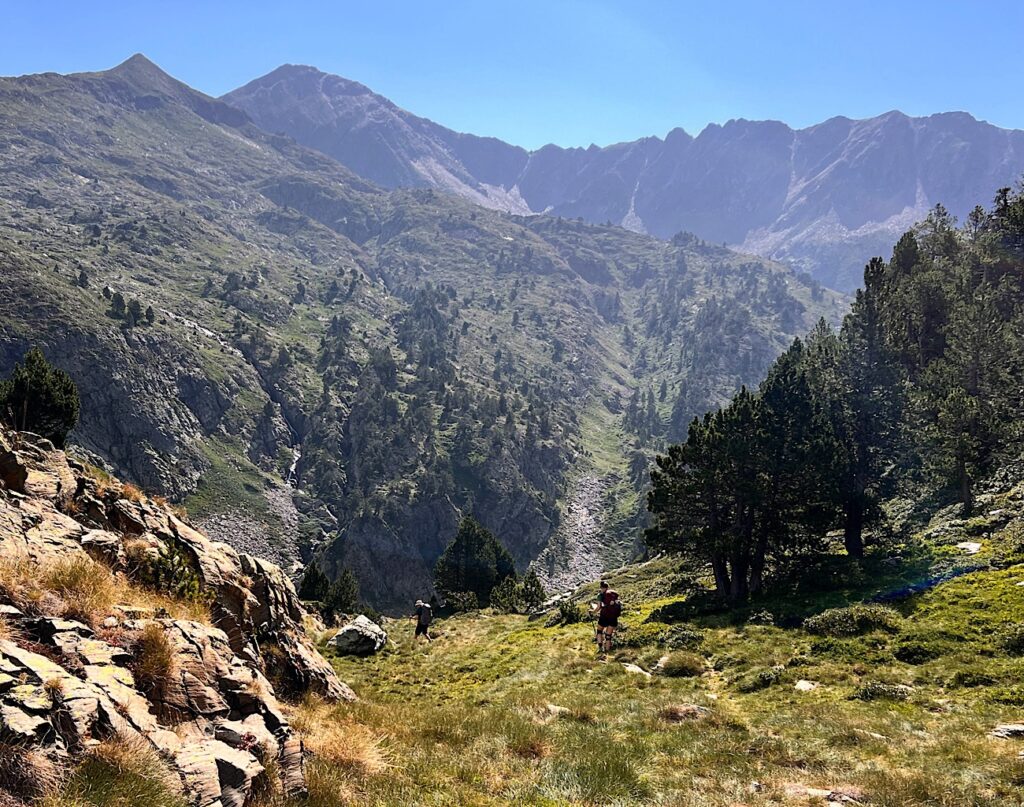
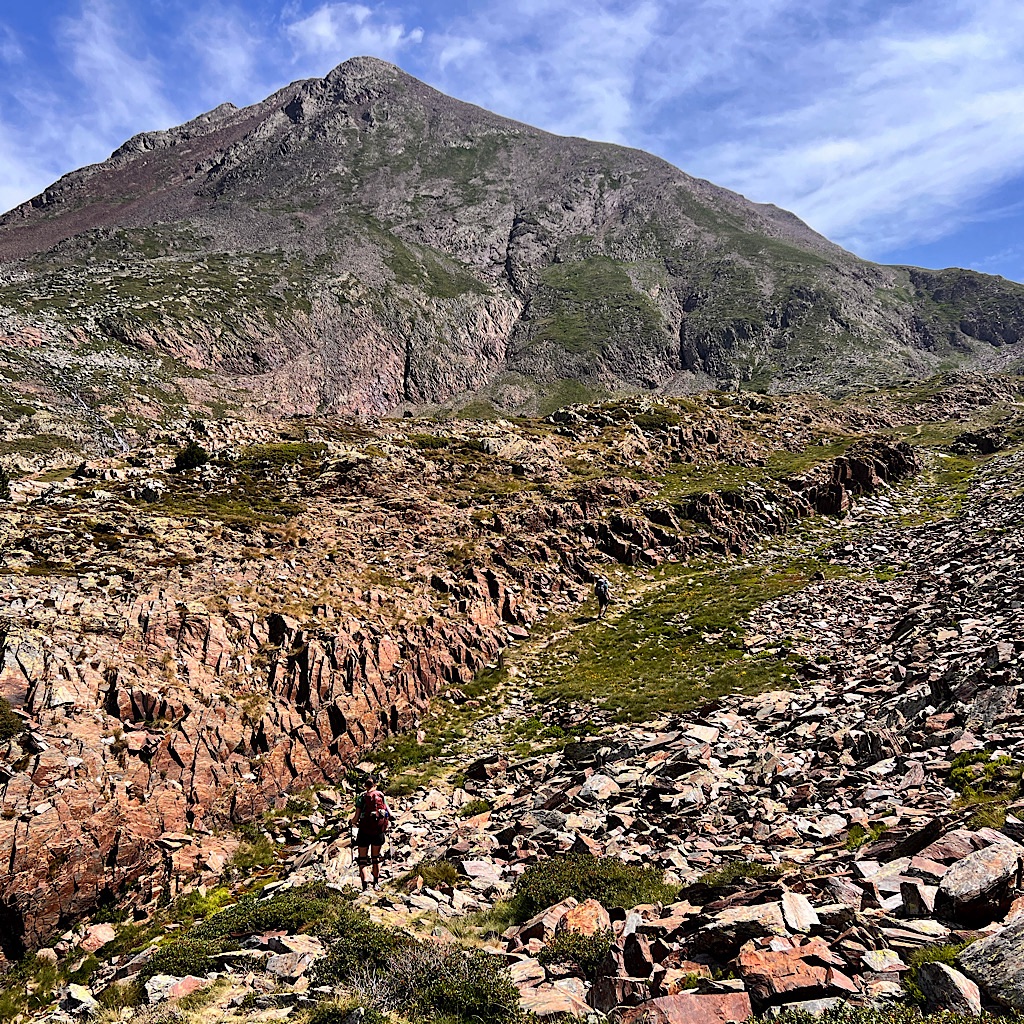
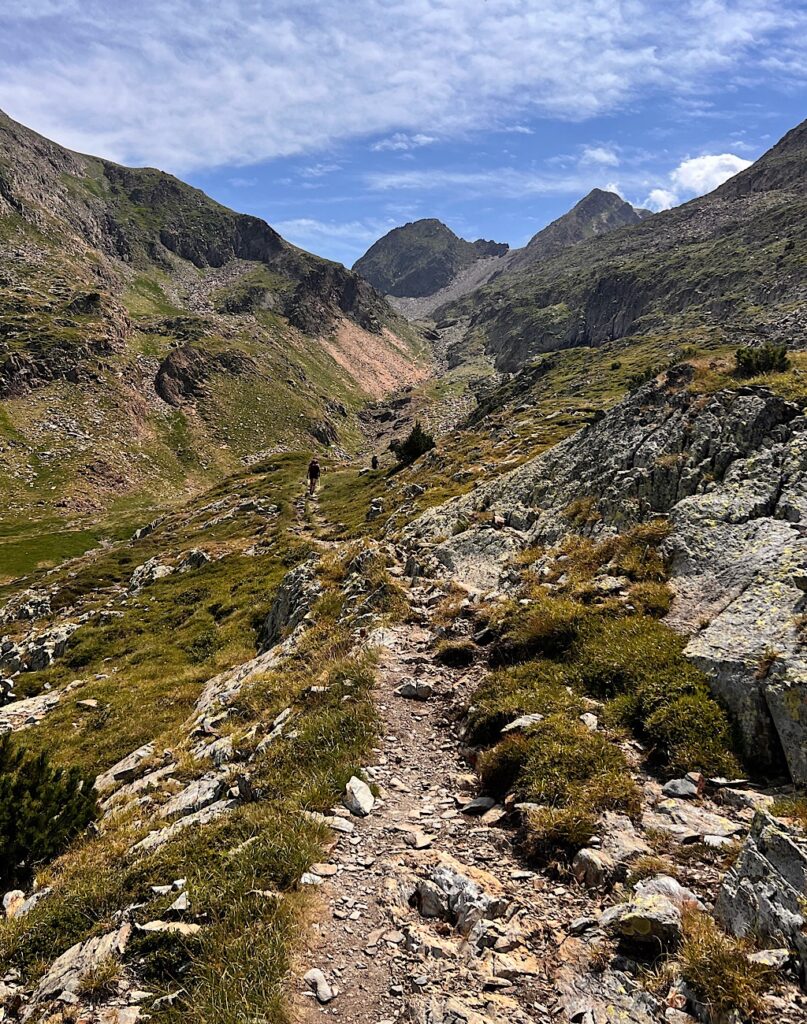
I’m up for it. Sure, it will still be work and there are some unknowns, but the valley is over 1,000 meters below, hotter and not as gorgeous.
So off we go, immediately locating cairns (again I ask where were these on that incredibly tough day one out of Salardú?!?)
It’s climbing, but lovely up to the spot where we traverse. Sebastian gave Floris an altitude, and spot on, we find a way around to avoid cliffs. Good work!
When we meet a main trail coming up from the valley, well-used and thoroughly cairned, we spot a family, and our sense that we’ve done something extraordinary by going off-trail completely wanes.
Then, the climbing begins. Nearly straight up on grassy stairs to a wee pass through trees, up more to small lakes and huge views, and another one of these tree-lined avenues popping us through the mountains.
It’s all steep, and oftentimes, I need to keep my eyes forward and pay no attention to the steep drop to my right. It may not be the easiest walking, not always on trail but more humpy grass – and are we really saving time? Maybe. The idea is that it feels more like a route should feel, wild and untamed.
Although even up here are “semi-wild” horses fitted with tracking devices.
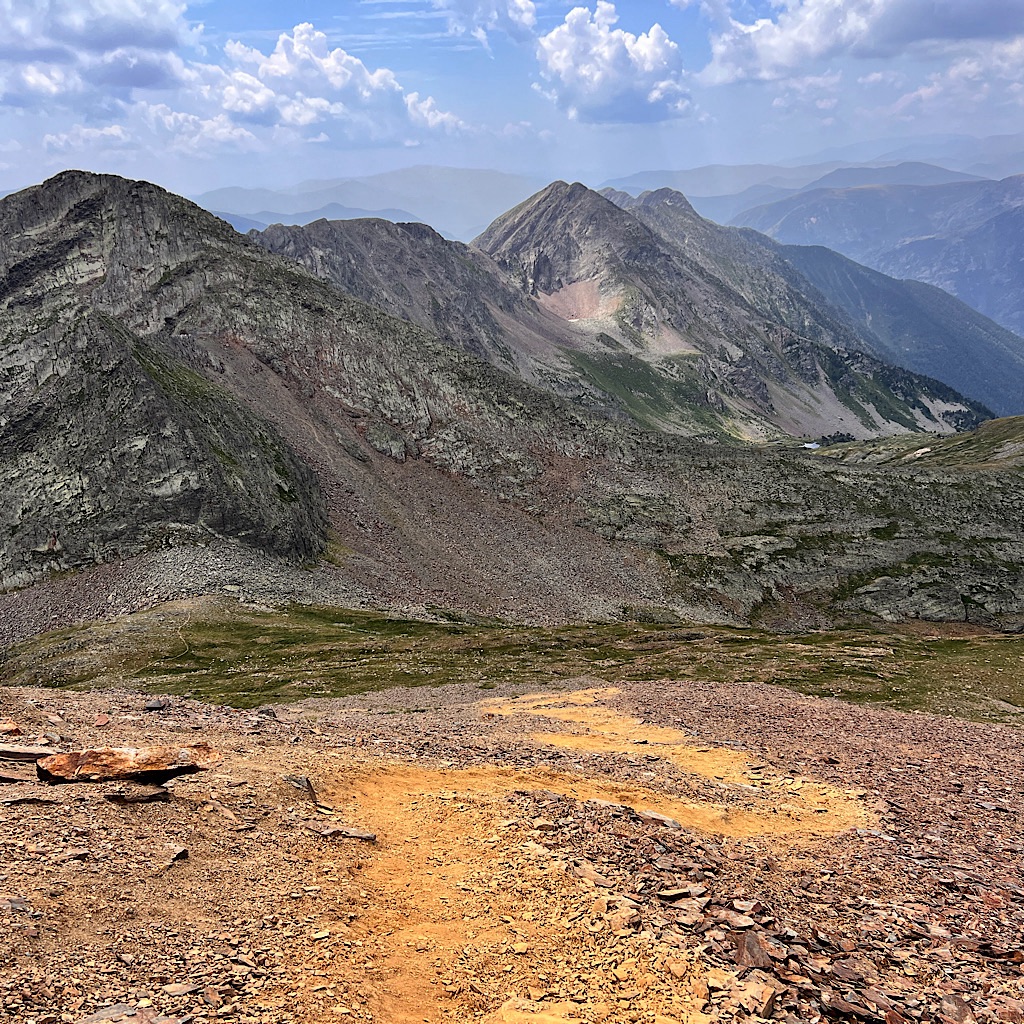
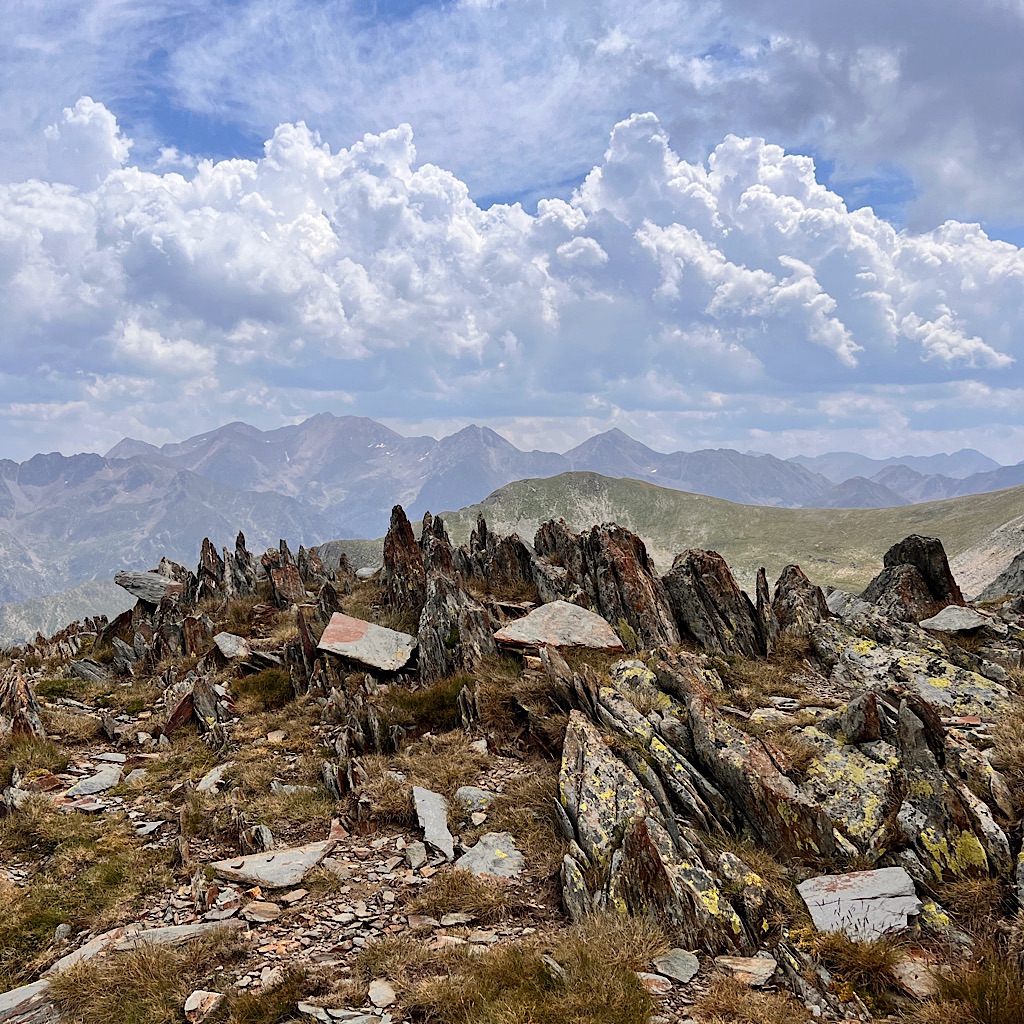
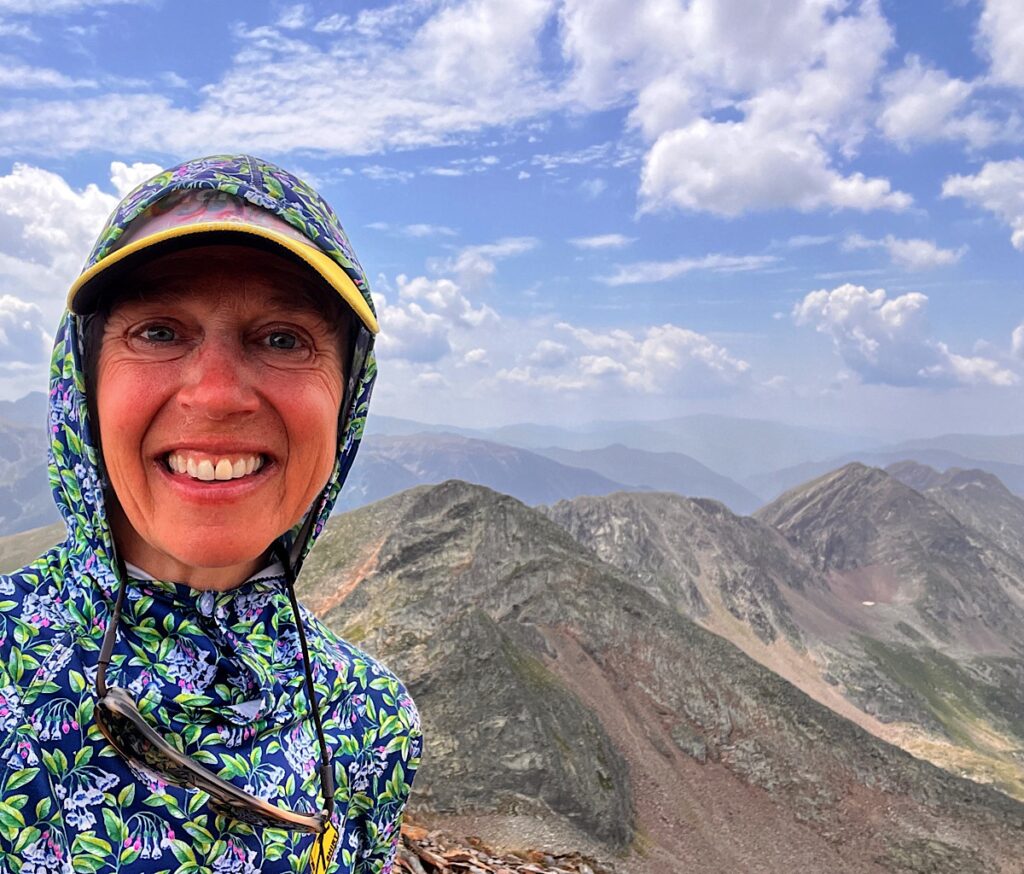
It’s down to another gorgeous lake, then steeply up to another and we’re back to the trail, breaking for lunch when the first clouds begin to form.
In the guidebook for the John Muir Trail, there’s a warning about afternoon thunderstorms with a picture of a wee cloud in a blue, mostly cloudless sky. The caption warns that a hiker needs to keep their eyes on wee clouds like this, which have a tendency to turn into terrifying cumulonimbus in short order.
We climb steeply up through shattered rock to the col, arriving at 12:30. The trail to Pic de Certascan begins here.
I’m tired, bushed, not able to make good speed on ups, which is my forte. Likely it’s the heavy pile of food in my pack weighing me down.
The sky is filling with clouds but I think I can still get this small peak, an hour at the most.
So I drop my heavy pack and ask Floris if he might ask for a bed for me in the refuge when they arrive, and off I go.
Life is better without a pack and I fly right up on a very clear path, steep and full of small rocks. There are several people coming down now and I’m quite alone.
It is beautiful, watching the next valley open up, a deep cerulean lake amidst white, craggy peaks, mist pushing in from a bed of clouds below.
The rock is some kind of shale-like metamorphic rock, broken into sharp points like spears.
When I reach the top, the clouds have filled the sky, gray and angry. Suddenly I feel afraid that I’ll be caught in a storm while trying to descend on slippery rock. Not-to-mention it’s another hour’s walk to the refuge.
So I snap a few pictures and head right back down. This steepness is not as bad as others because I can press my feet into the stones and, for the most part, they hold me. “Embrace the slide!” Floris might say.
I’m down quick enough, then put on my heavy pack to descend to the refuge. It’s shattered rock and requires my attention, but not too complicated as I look back to see black clouds above me.
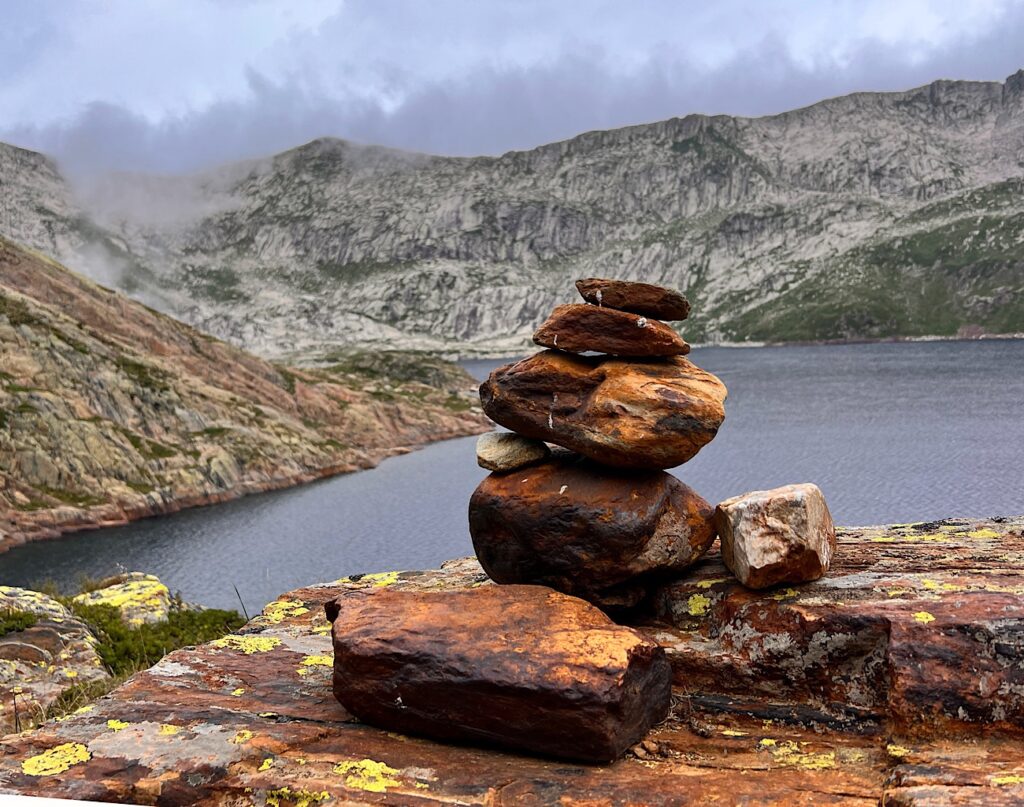
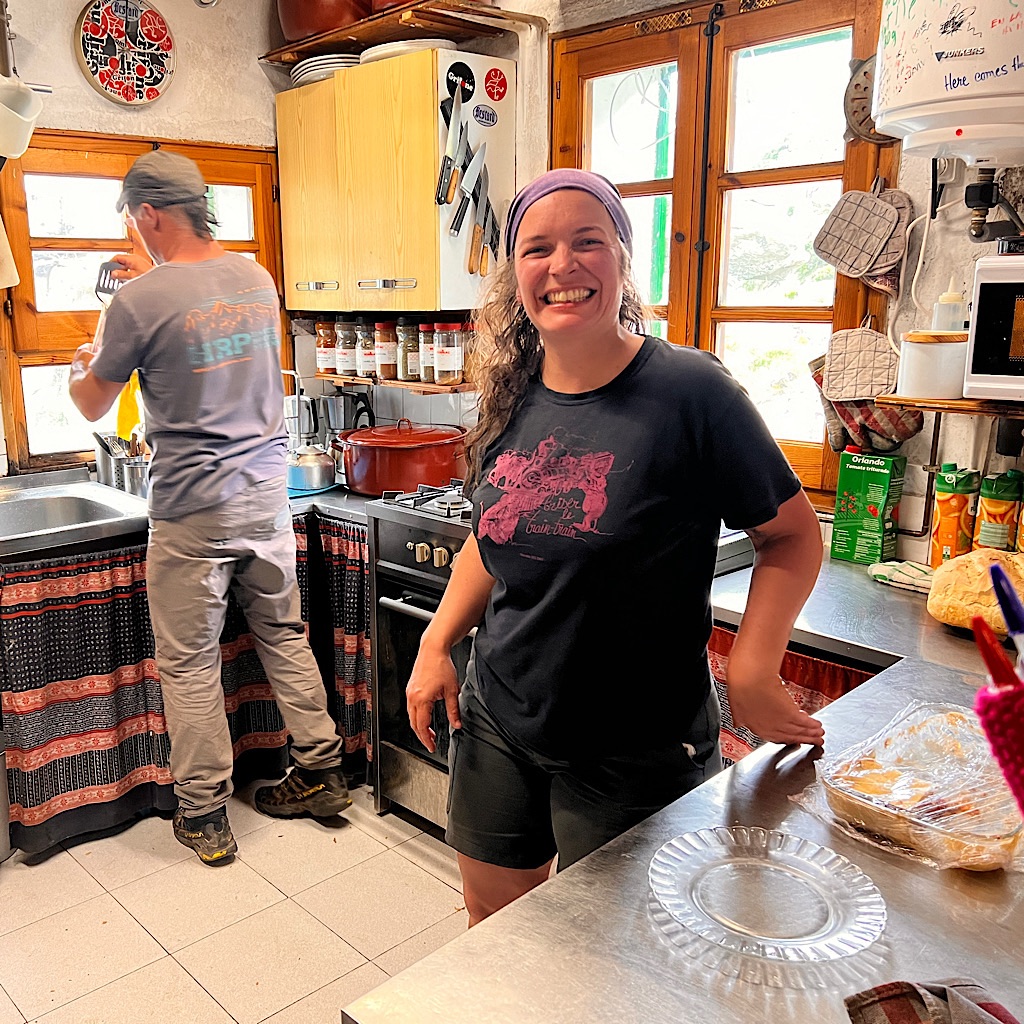
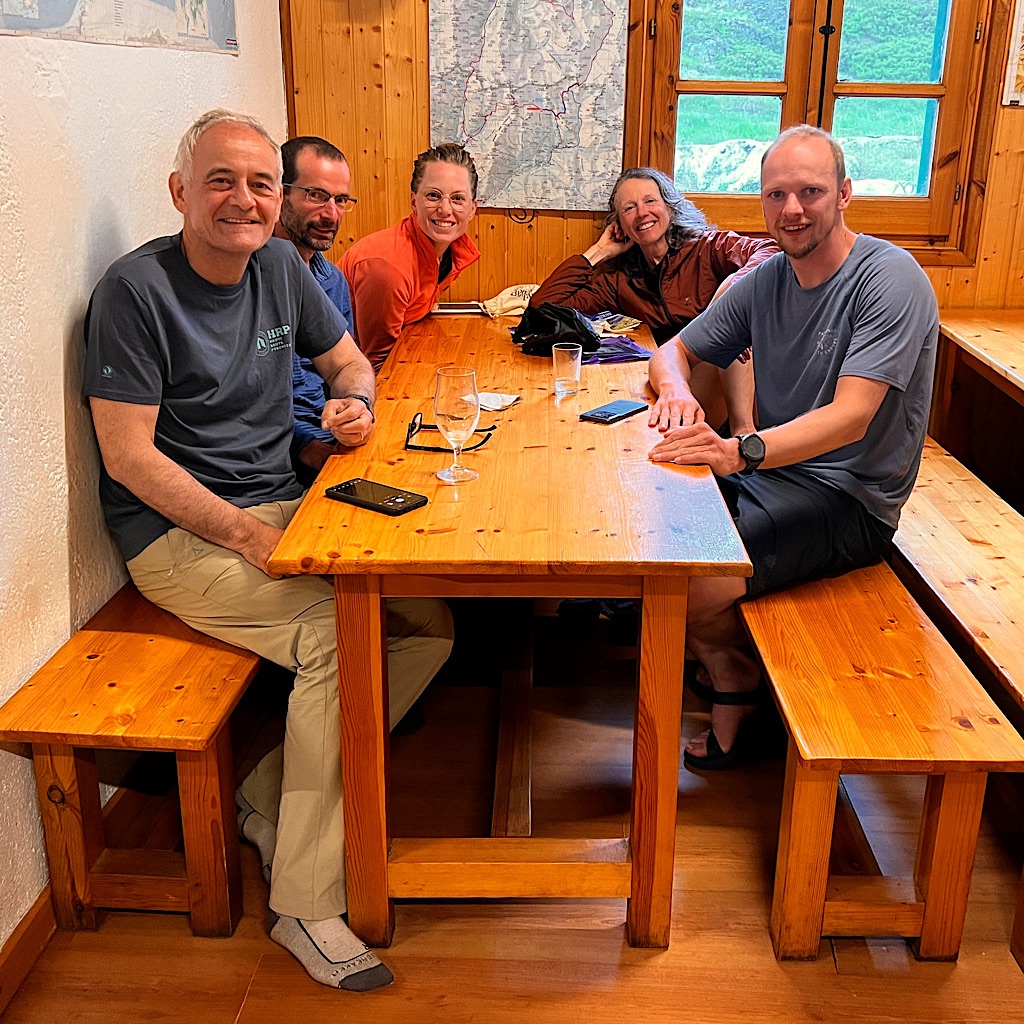
That happy little cloud really did grow into a severe storm.
I move among cows and streams, reach the gorgeous lake, then need to rise a bit and eventually sidle a small cliff.
That is the precise moment the thunder begins roiling. Then mist engulfs the lake and hits me like a squirt-gun.
I just stay focused and move along, only a few more steps. It’s not raining yet.
I first cross the tubes transferring water to the refuge, then a kind of housing for plumbing, and finally, the refuge.
Floris is waiting, clean and fresh. “Run!” But no need to now. Sebastian is here, and John from so long ago, Stefan, another HRPer and a young Frenchman who finished it, and is now walking back.
There is a bed for me, and I’m glad of it because the storm is absolutely raging. We’ll sleep like sardines, but I don’t care. I love the din of all the languages, and I have earplugs when it’s time to sleep.
Right now, I watch and listen to the storm which I was wise enough to get myself out of.
And in less than an hour, dinner will be served!
Day Twenty-six, Refugi de Certiscan to Pla de Boet
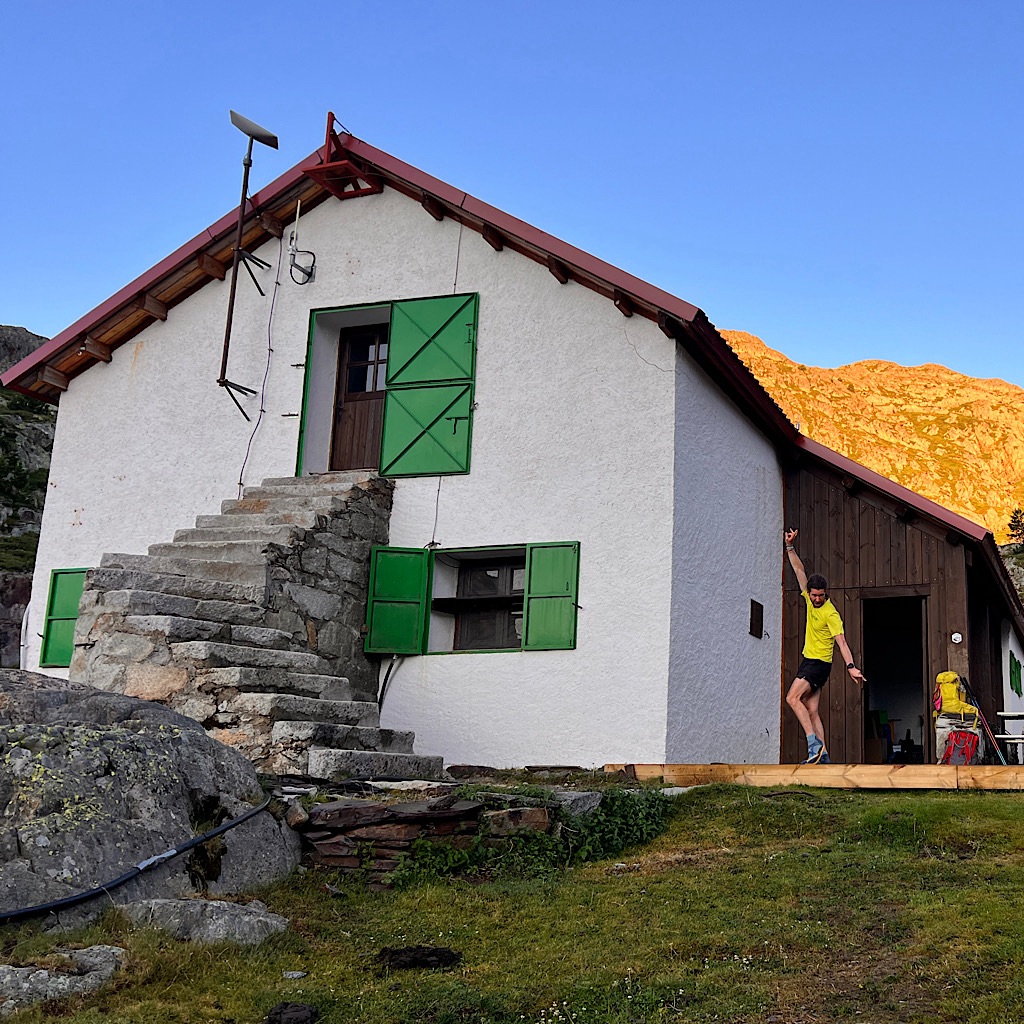
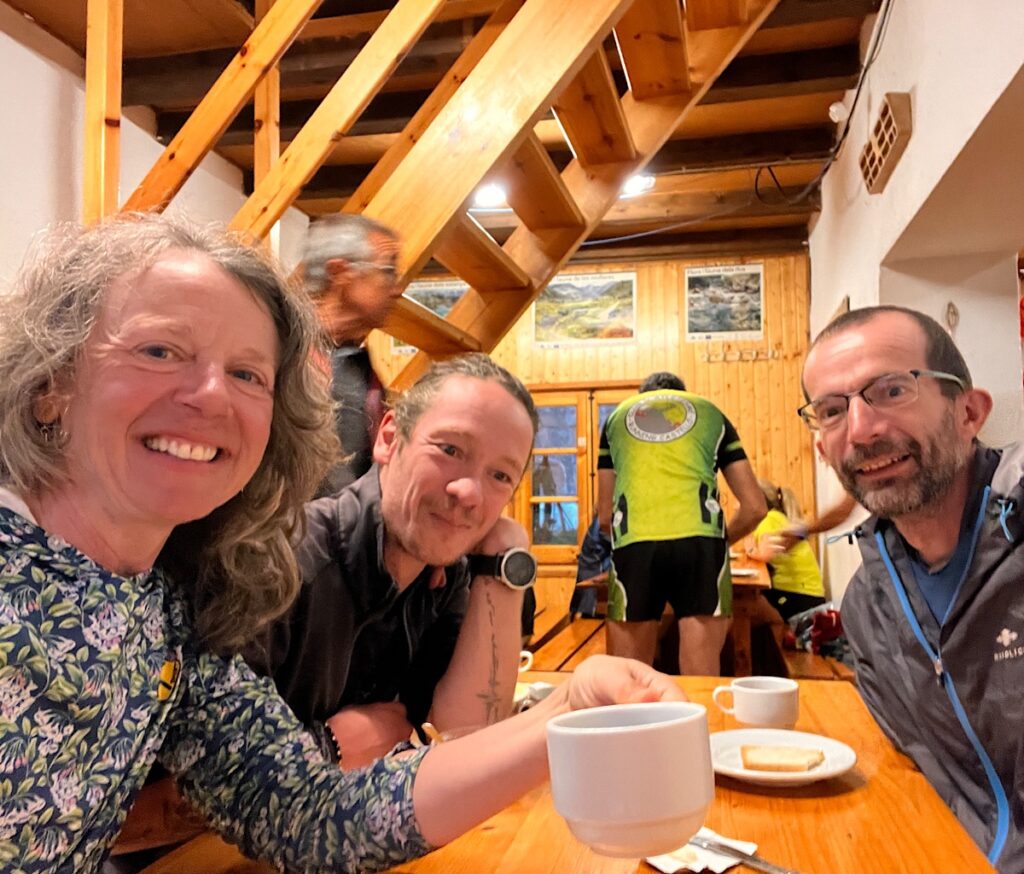
I am surrounded by waterfalls.
Well, in a V anyway, with two that would be considered a spectacular natural wonder anywhere, but here, make up the finale to an entire day of waterfalls.
The day of waterfalls. That sounds absolutely fitting.
And so good to share this story with you now from my own little bed in my own little tent hidden amidst this spectacular setting.
Last night was an anomaly. The thunder crashed for hours and it poured, so clearly it made sense to stay in a refuge. My Dutch friends were there, plus John from weeks ago, Sebastian, a new German Stefan (who was as wildly ravenous as me) and “RV,” a French van-life hiker.
So it was fun and safe and dry, plus I cured whatever was ailing me and causing me such severe exhaustion. I think I was slightly malnourished and the good food here of salad, quinoa, garbanzo beans and meatballs made me a new woman.
But I must say that refuges are getting very expensive. I could hardly look when the bill ran up over €75, and that was the cold shower version.
Funny how they feed us, then charge us, then we get to try and sleep. Our beds were so snug, I must have walloped Floris and nameless Spanish dude over and over.
At one point, I woke up drenched in sweat and in a panic. The Dutch left the dorm and set up their mattresses in the dining room. They opened a window, and wave upon wave of cool air massaged my body and I finally drifted off.
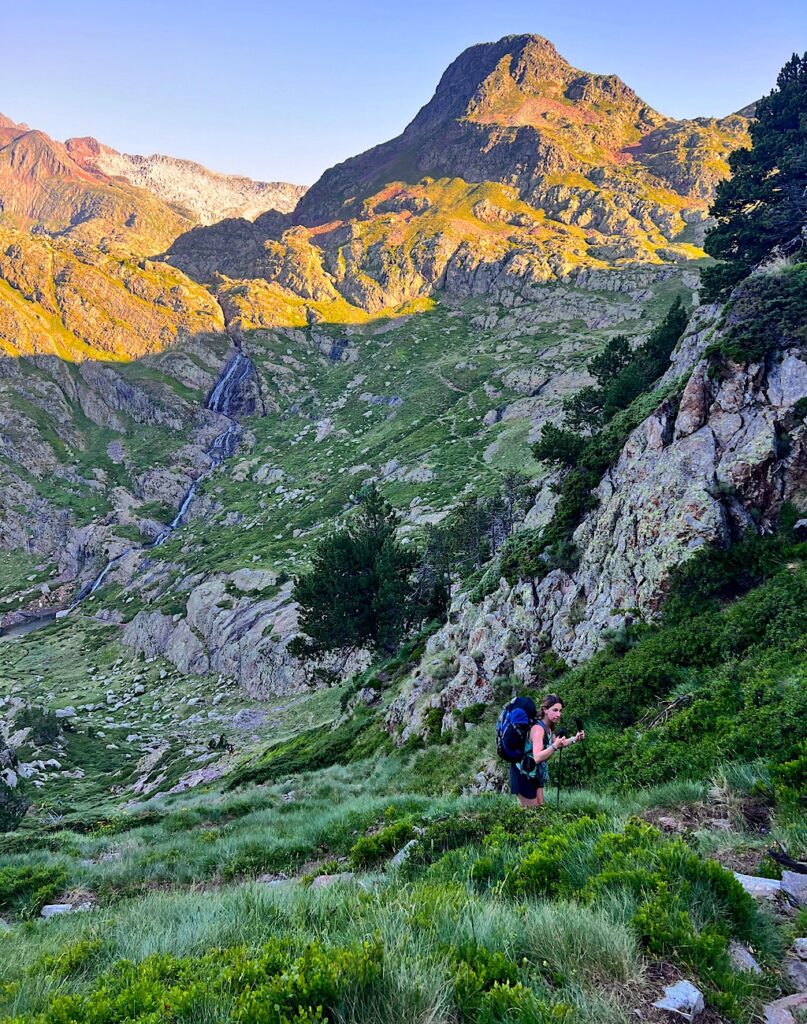
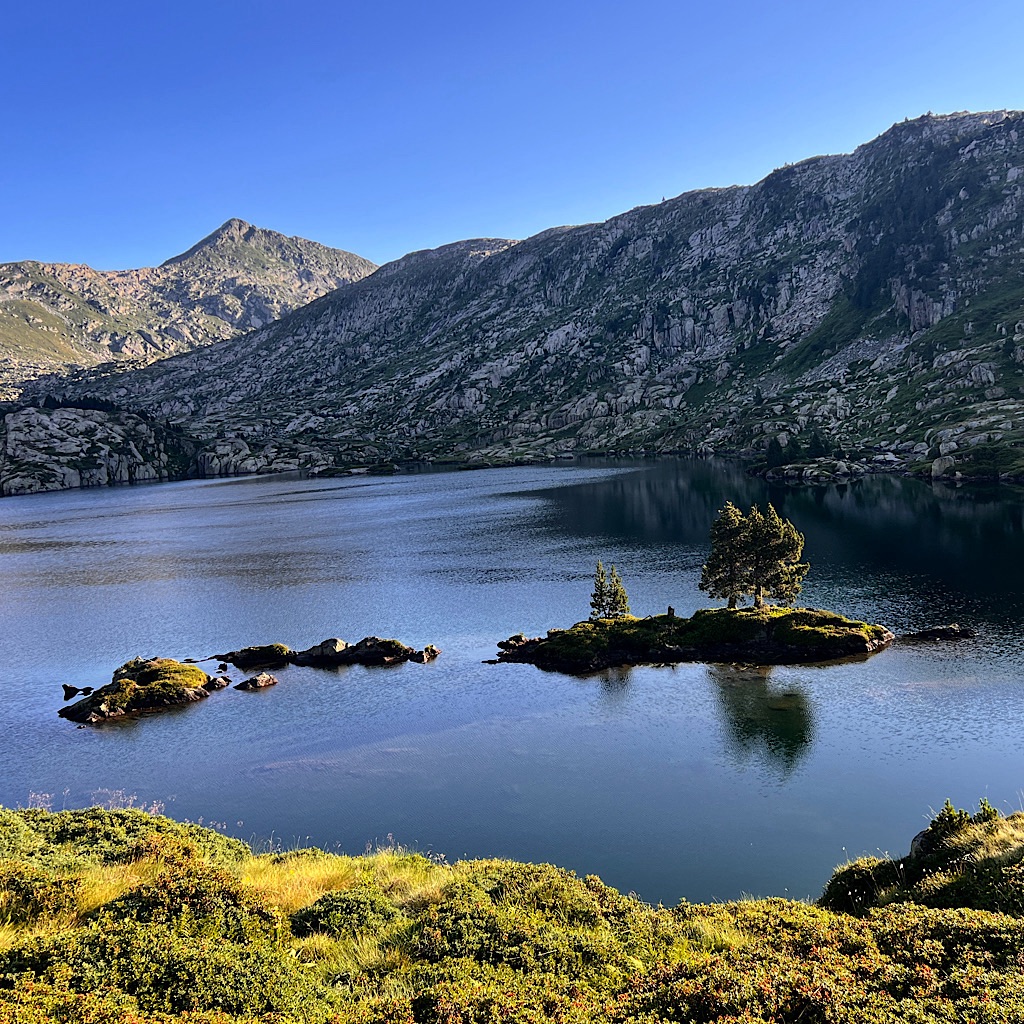
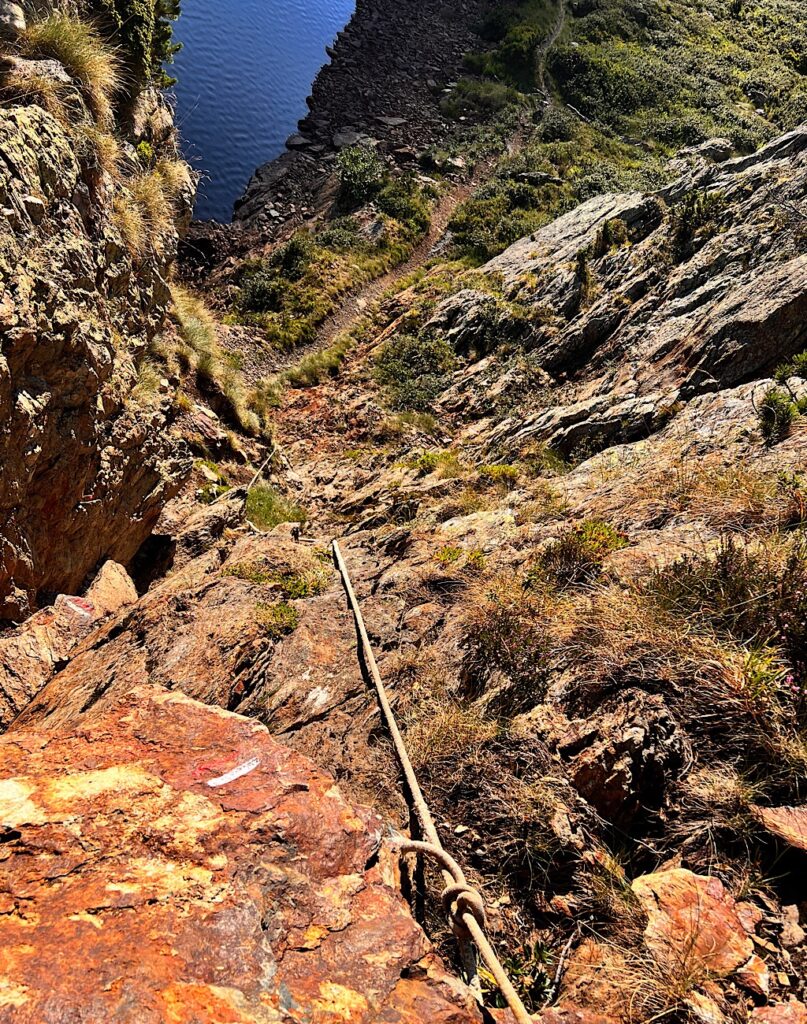
Breakfast is decent as I bid adieu to the French who will take a different route. As awful as sleeping was, I feel so much better with good energy, and that in itself is worth every penny.
The route is out and down a huge canyon today, gorgeous rock and, as is typical here, simply huge. I see the Dutch head up a side trail and I realize they found an alternate “high route.”
So, I follow them. Too far behind to really catch up, but up for another adventure. There’s no route finding as, at least according to my map, these are actual trails.
But in the Pyrenees, it’s anyone’s guess what’s ahead, and as I climb steeply (much stronger than the last two days) I ask for guidance and protection ahead – and that nothing is put in front of me J can’t handle.
As I move east towards Andorra, the mountains are drier. Fewer flowers and more reds and browns. I meet a lake which spills down into another, losing the track momentarily before locating it heading high to avoid a cliff.
Remember how I got seriously off-route the first day out of Salardú and found myself traversing with serious exposure? I should mention here that both John and Stefan did the same at other cols, making risky moves to get themselves back on track.
When I tell John we could have been killed, he simply says, “Yes, we could have.” Makes me shiver just thinking about it.
This off-route is nothing of the sort, but when I need to circumnavigate the lake, I see a nice rock climb ahead. Far on the other side are the Dutch and I wave before shooting up it and sidling a cliff.
Wait a minute. I waved to them next to the lake. That means I will be coming off this cliff. And I do, even steeper than I went up, though someone conveniently attaches a rope to hang onto. How thoughtful.
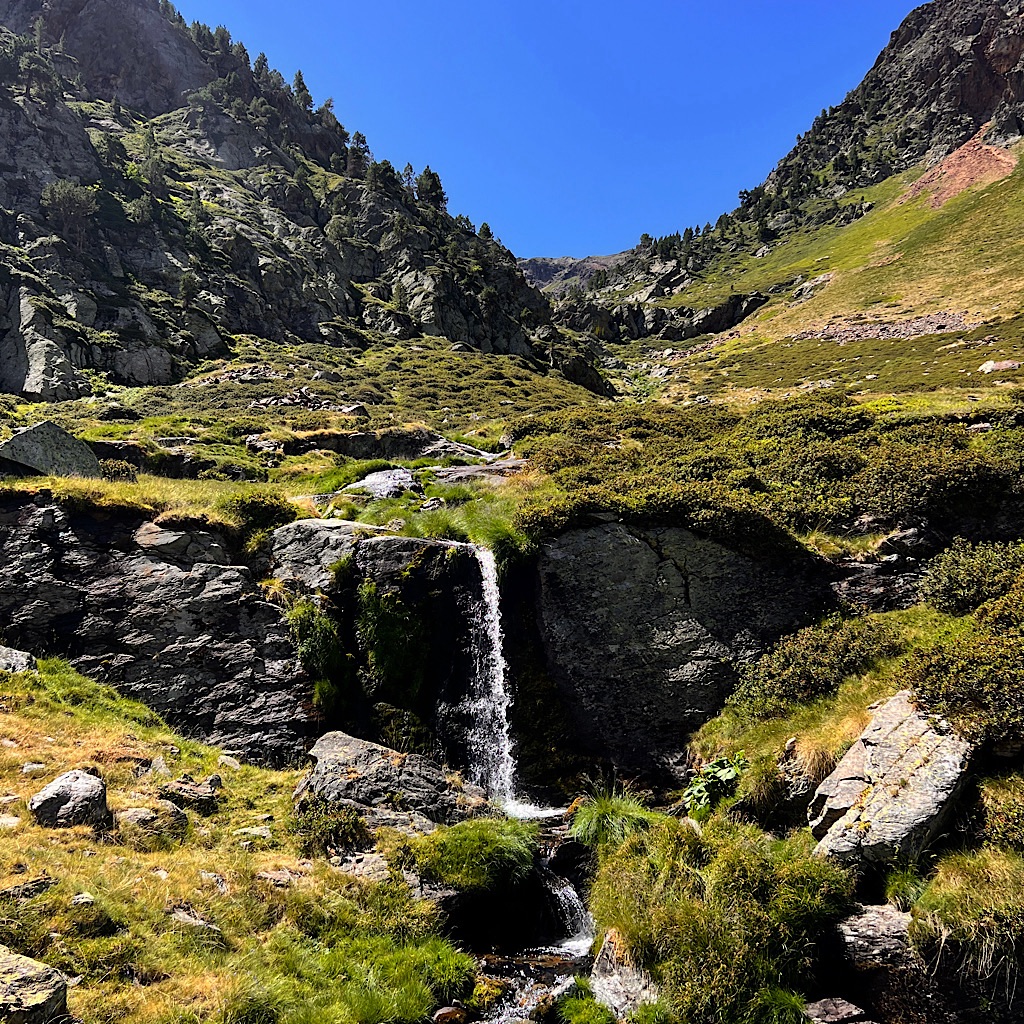
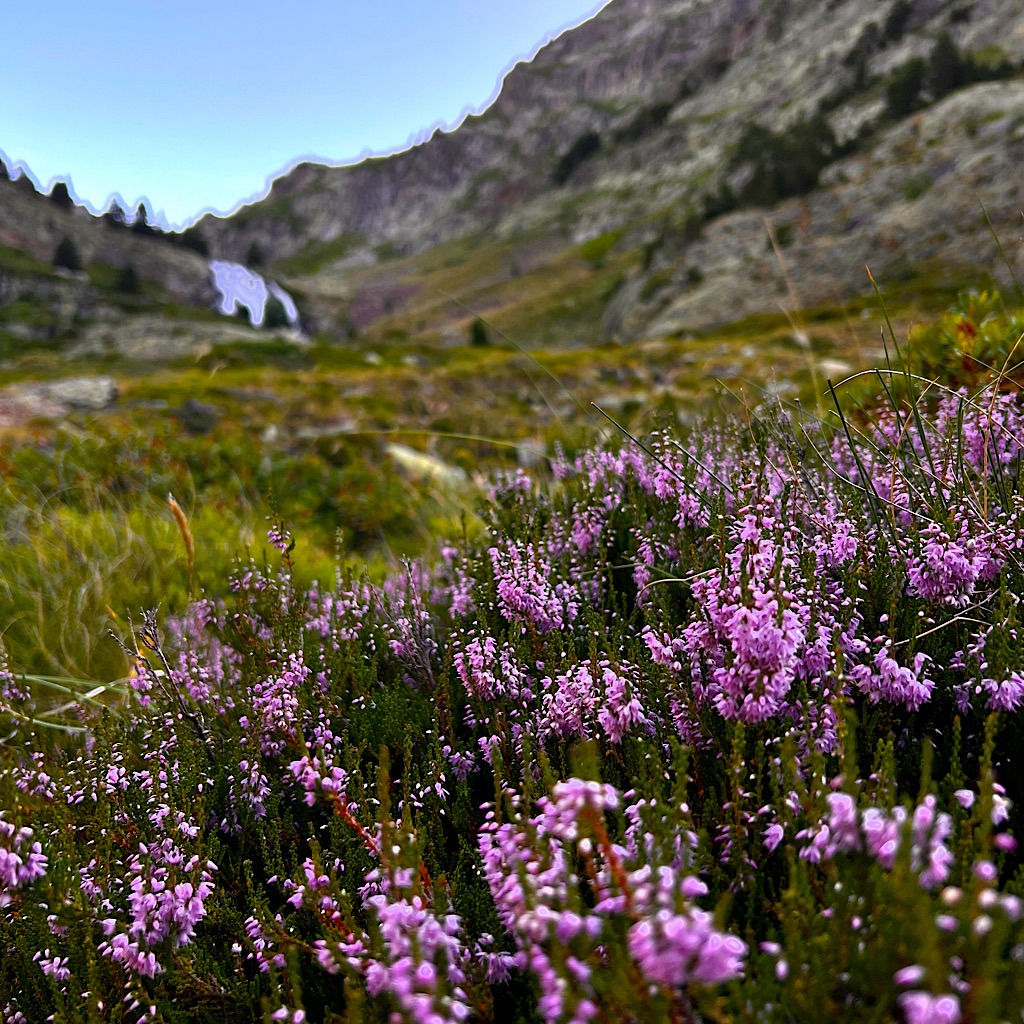
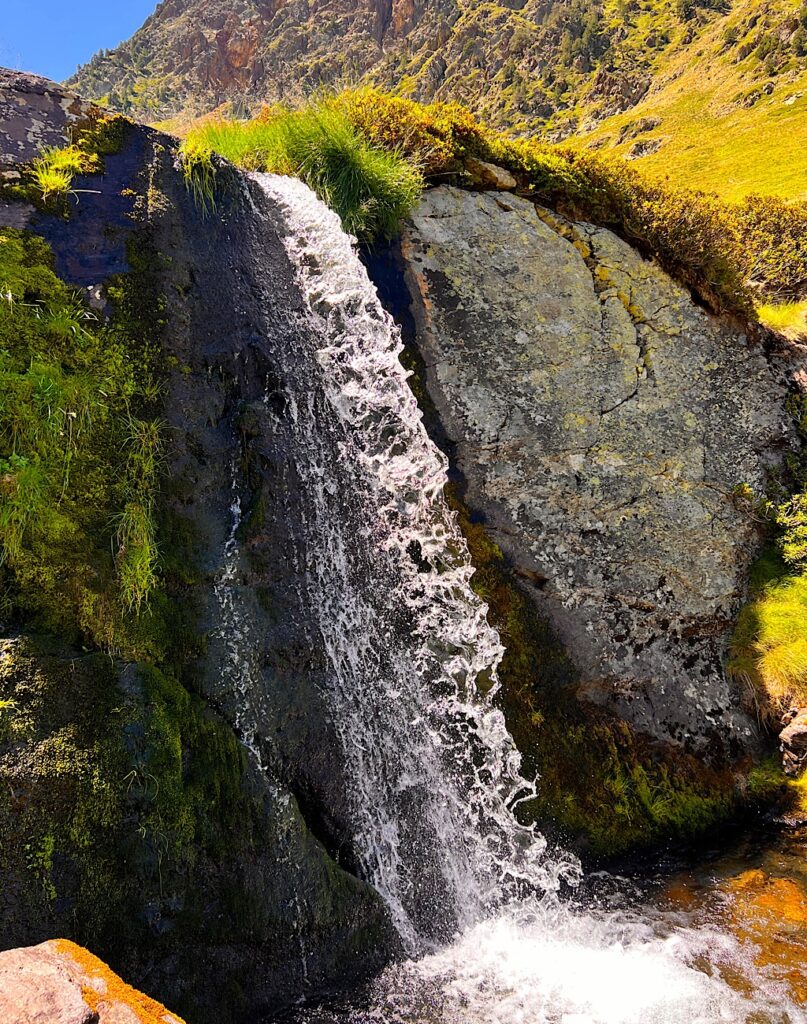
Even way up here, the lake is dammed and I cross it to access a cairned trail following the outflow all the way back to the HRP.
It’s a stunning valley, filled with falls in all sorts of shapes and sizes. There is a kind of path, but mostly I look for cairns and walk on humpy grass.
The sound of crashing water is constant as I work my way down, sometimes meeting steep rock walls that require careful handling.
At one, the handle of my pole snaps and I’m left holding it as the other part shoots down like a rocket. Somehow, some way, it sticks into the ground right at the trail, and holds there, quivering slightly, but not continuing its trajectory out of my reach in the falls.
Talk about trusting existence.
I grab it and find a way to keep using it without a handle, because I really need sticks to manage this tough walking. Beautiful, otherworldly beautiful, but tough.
I see the long valley I’ll eventually climb to a col and a new valley, but for now I need to continue descending, hoping I can manage all the rock ahead.
I make a wet crossing, then enter a very dark forest. No rock in here, just hard to see as I look for cairns. After all the wild things demanded of me thus far, I fully expect simply a rope or a log to help me cross the rapids from high rock.
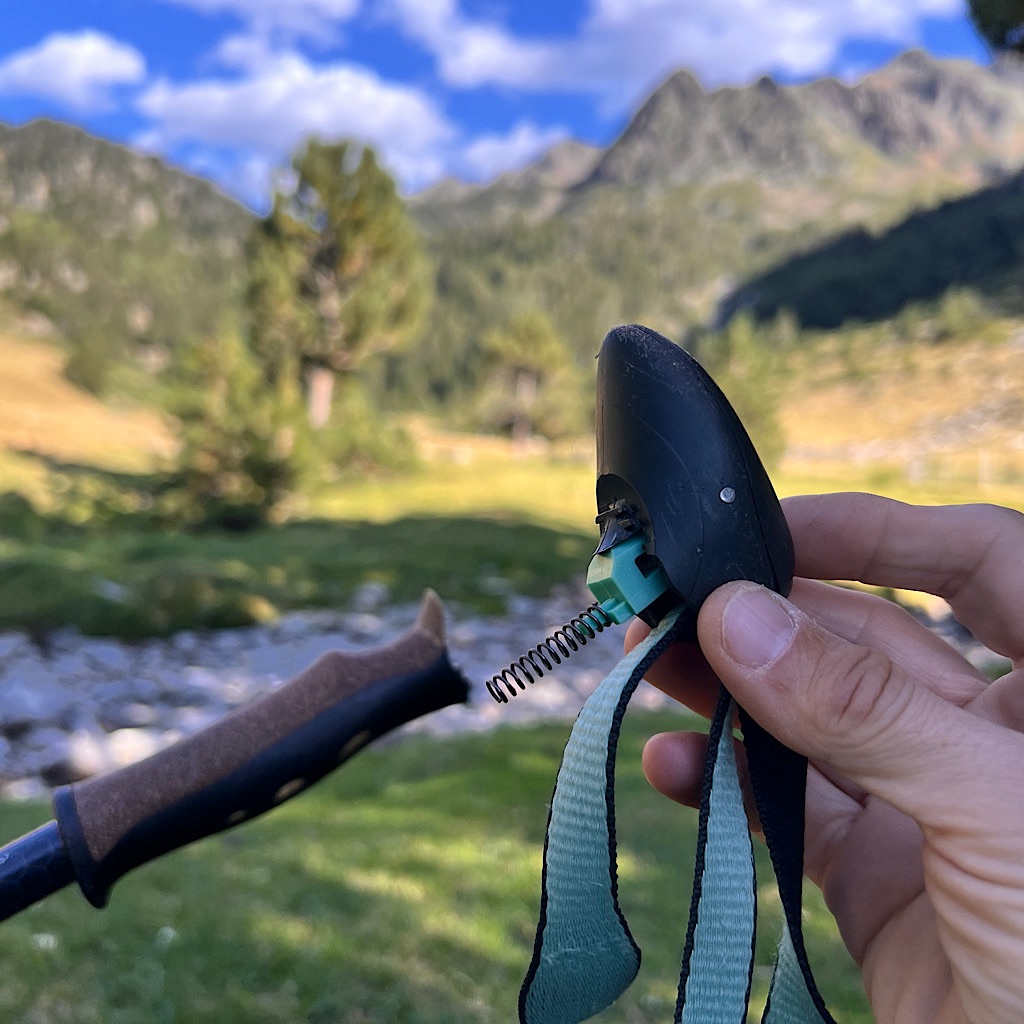
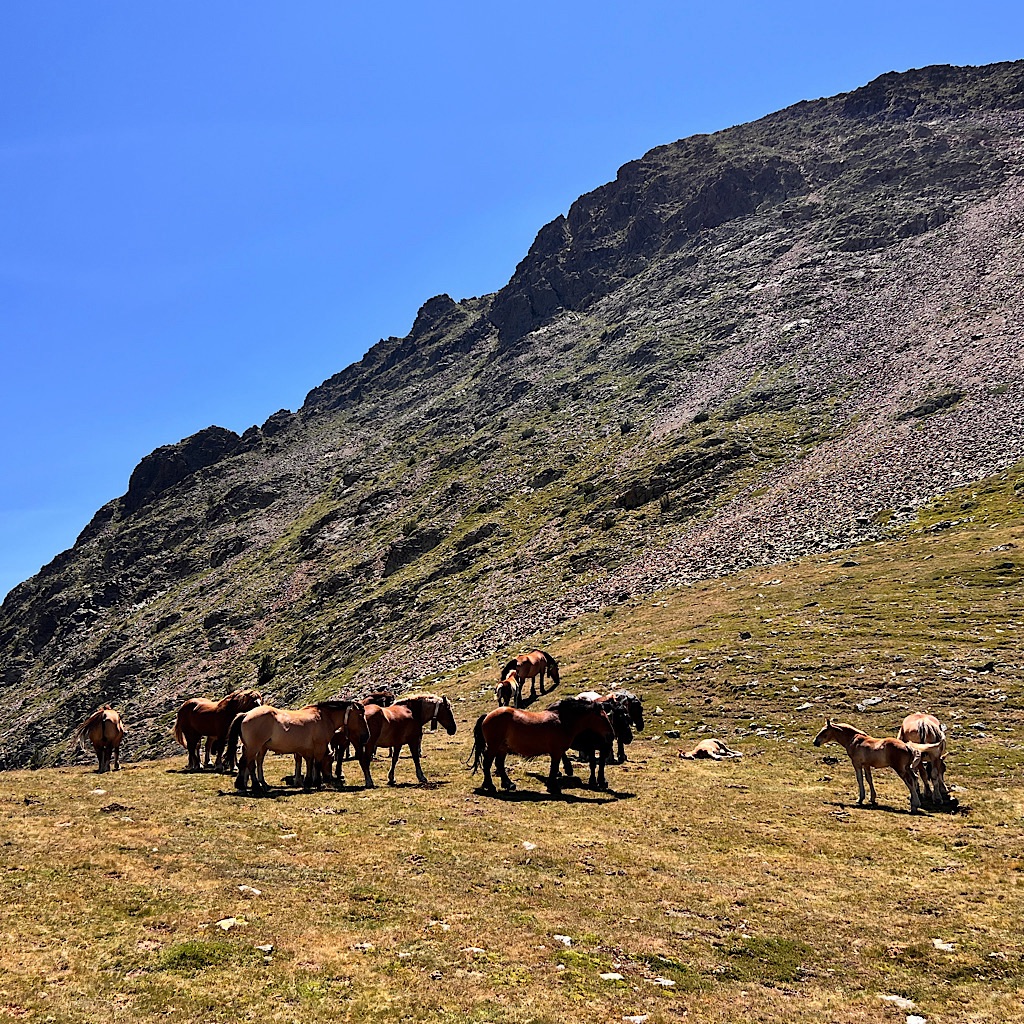
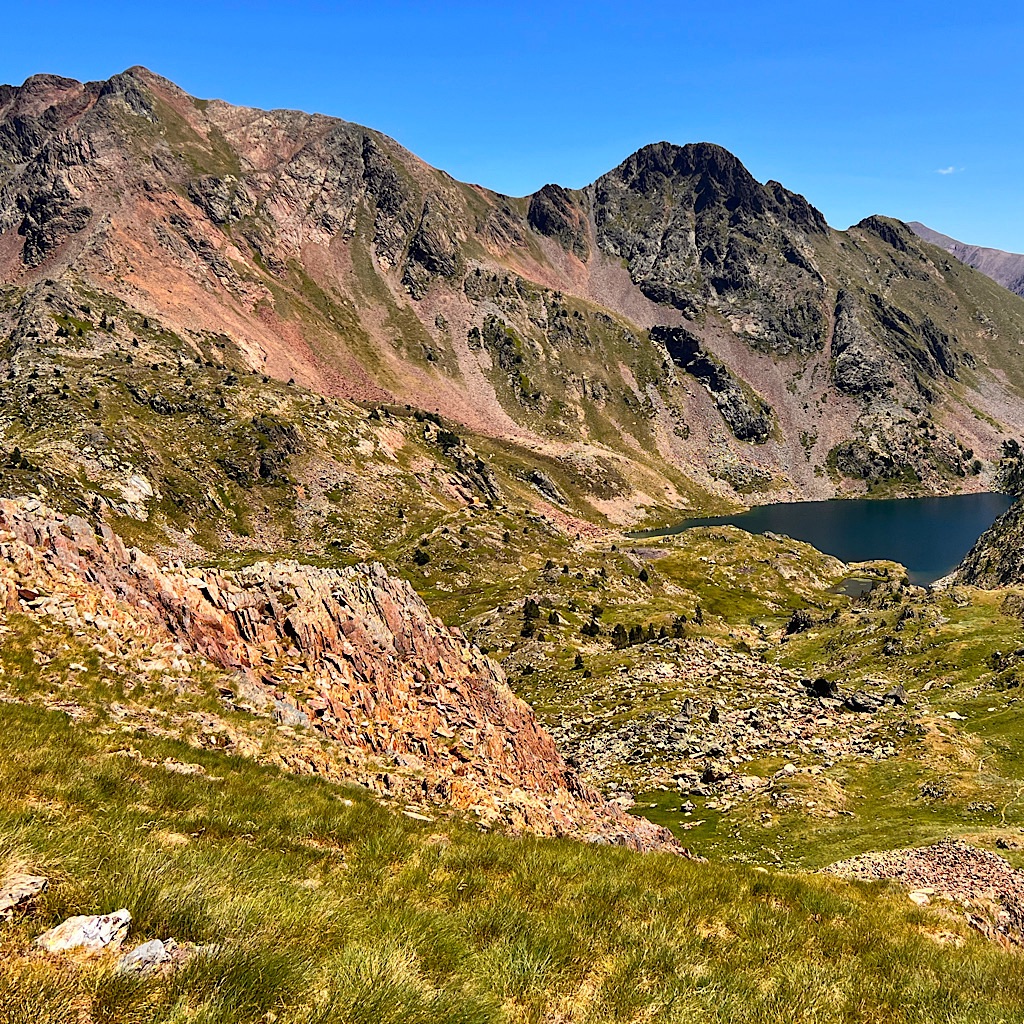
But I’m shocked to find a bridge! at Pont de Boavi, as well as the Dutch who tell me this route is the route and my GPS track was wrong. Ah, ok. A very nice and exciting route!
Now, it’s all up.
The HRP is totally inconsistent. One minute, you’re downclimbing a rock wall, and the next, you’re climbing up on reinforced zigzags. It’s steep, but easy walking up and up, until my turn off for the col through blueberry (guide calls them bilberry) bushes.
My tempo slows eating as many as I can pick in this gorgeous valley, again filled with crashing water.
I come to a plateau with, of course, pretty brown cows. A waterfall pours down as if a spout and I choose here to cool my feet and eat lunch.
My view looks back to the long valley I descended. Even from here, I can see waterfalls cascading one atop the other.
Wow, nutrition really matters. I feel so much better all over, even after a long morning of focused walking. The grass is so soft to sit on and the water just the right amount of coldness for my feet.
I eat a nutella wrap, cheese, dome salami, cashews and dried apricots plus drink an entire liter of water, then press on for the col on long, slowly ascending switchbacks.
A man passes me who I later learn is Johannes hiking the HRP bit by bit. This must be day one, because he flies by, then stops, leaning on his sticks like he might barf.
Meanwhile, I chug up not winded, not tired, not barfy and really, not fast. Horses graze right at the col, perhaps also enjoying the view, then it’s down to gorgeous Barborte Lake, nestled in pine-studded rock like a sapphire.
The unmanned refuge is bright orange, though nearly blending in with the rock. It’s similar to Pujol, strapped onto rock with cable.
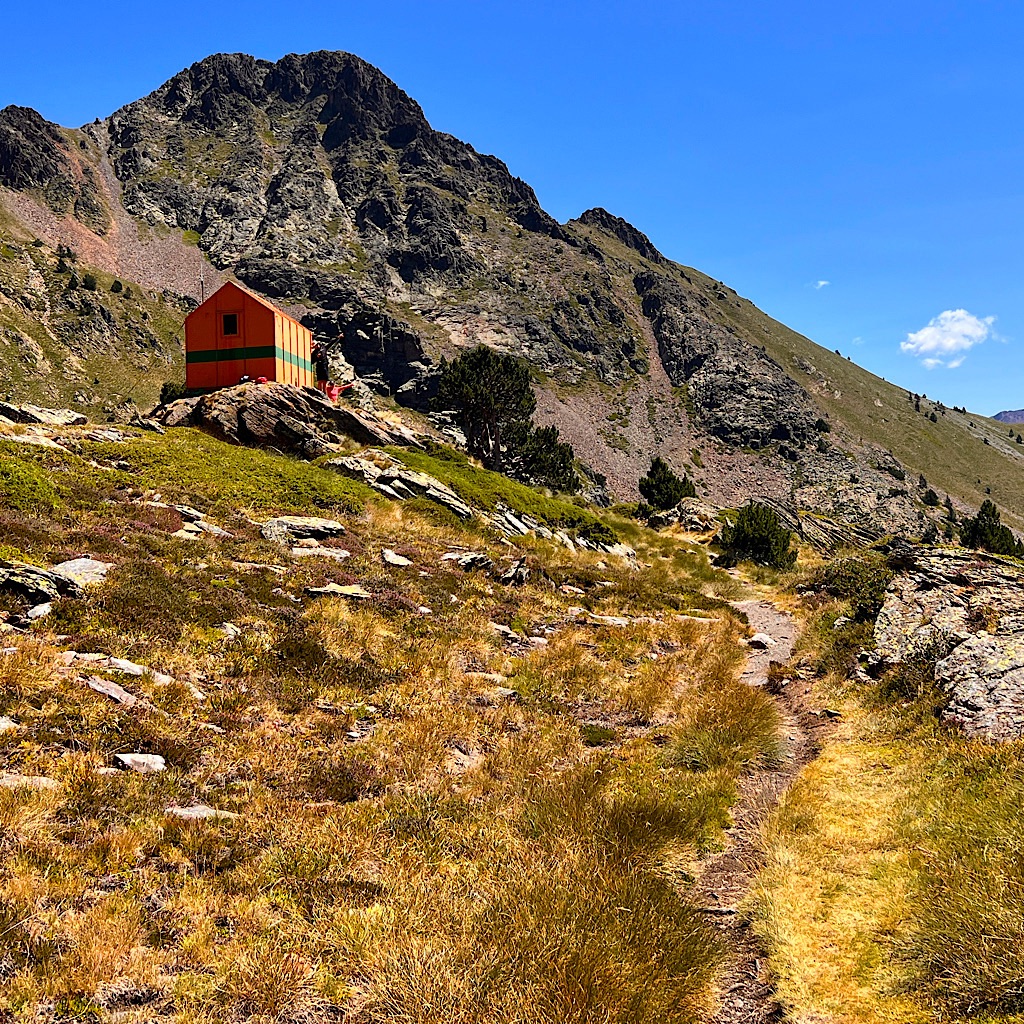
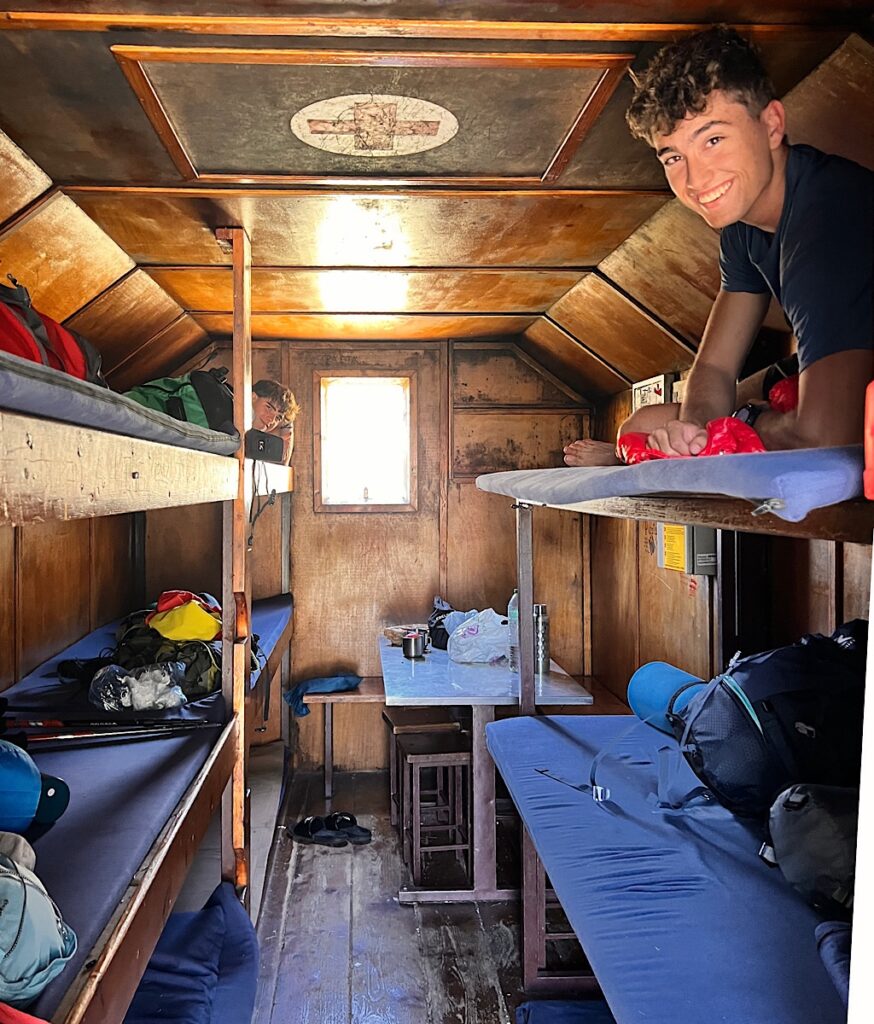
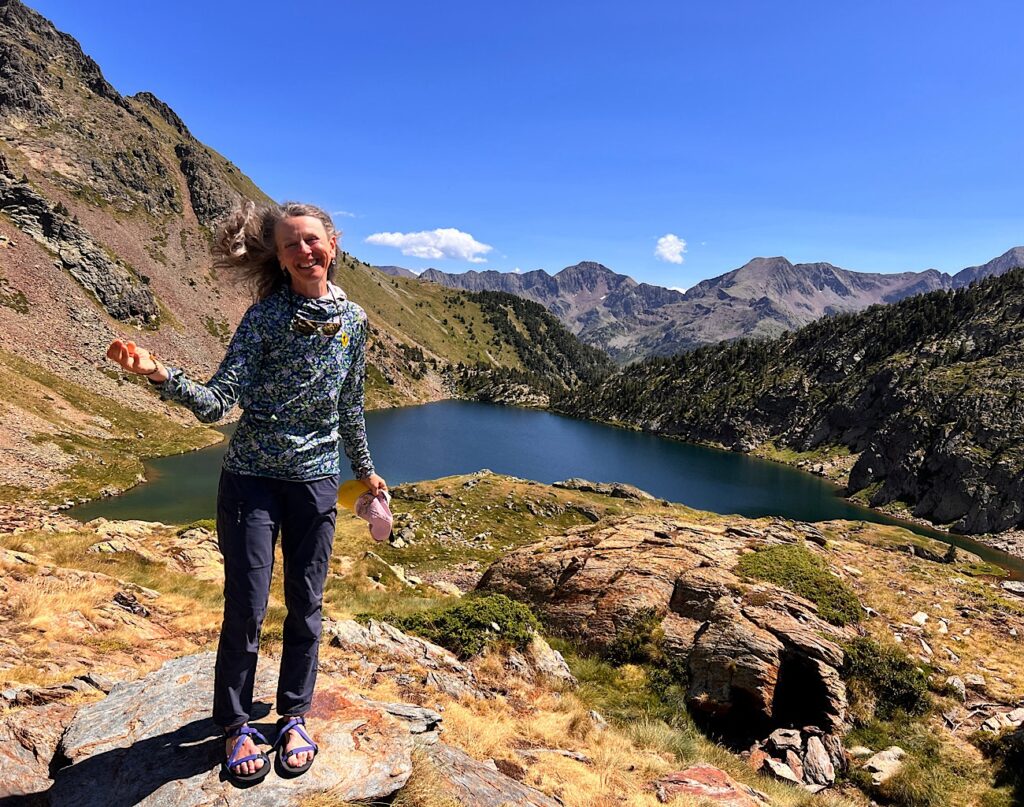
I visit with the Dutch who set this spot as a meeting place with his dad and brothers, who will join them for the upcoming four days through Andorra.
The air is perfect – sunny warm, windy chill in the shade, dry and fresh. I’ll miss my friends now, since they will likely walk much slower with new people on trail, but I imagine we’ll see each other on the final stage.
I head on, going steeply down into another giant valley, before turning up a new one to again move towards a col.
It’s hot here and I’m thirsty, happy when I find easy access to yet another gorgeous, crystal-clear stream crashing through the valley.
I pass many cars and the turnoff for a refuge, then come upon this beautiful Pla, a meadow of many streams and crisply cut grass, nibbled down by a herd of bell-wearing horses.
I don’t want to set to obviously, so I make dinner and watch a man with a German Shepherd bring salt and treats to the horses. He whistles a downward interval that brings them all in, then spends time with them, babying the sweet foals.
Finally the sun recedes and I find a flat spot across the stream from the horses. The sky is a deep blue and the tumbling water never ceases. I have a feeling I will sleep well this night.
